Elizabeth Minchilli's Blog, page 13
November 20, 2019
Italian Table Gift Box
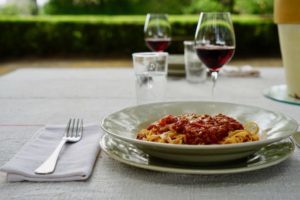
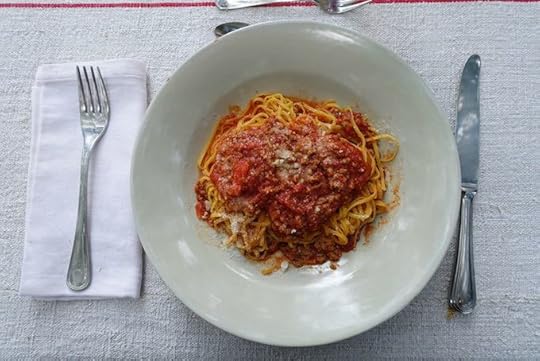
People are always asking me for trusted resources in the USA for buying the ingredients I recommend in my recipes. Things like pasta, olive oil, nuts and flour. It’s not always easy figuring out what is ‘real’ and worth the extra price to pay for high quality foods imported from Italy. I hope through my blog posts, books and videos that I convey the extreme hard work and effort that goes into making these products. But once convinced, where can you actually do some shopping?
One of my trusted resources in the states is the company Gustiamo. The owner, Beatrice, travels constantly up and down Italy searching out not just the best Italian ingredients, but those made sustainably and by people who are as passionate about the land and the food they produce as they are their business.
For the holidays Beatrice has let me choose a few of my favorite items and put them together in a gift box, along with a signed copy of my book, The Italian Table. It was hard to choose what to include (I want everything!) but I constrained myself. I decided to include a few ingredients that could help get you started on one of the most delicious menus in the book:
Lunch in a Renaissance Garden.
The Menu:
Bertolacce – Savory Crepes
Pasta with Ragu
Pork Fillet with Hazelnuts
Zucchini with Mint
Chocolate & Hazelnut Cookies
Your basket includes the following ingredients to help get you started:
•Maiorca Flour: A 1 kilo package of flour from one of my favorite mills in Sicily, Molini del Ponte. Their Maiorca flour is made from an ancient variety of Sicilian heritage wheat, and has no preservatives or additives. You can use it to make the crepes as well as the cookies.
•Sicilian Sea Salt: This is a pantry staple you probably take for granted, and is in every recipe in this meal. Sea Salt from Trapani is gathered on the northwest coast of Sicily and is not only nutritious and free of additives, but also produced in a sustainable way.
•2 bags of Spaghetti Faella: Even though my original lunch includes home made egg pasta, the ragu sauce is equally good atop by favorite brand of spaghetti, Faella, from Gragnano
•4 cans of Italian Plum Tomatoes: It’s not always easy to find high quality Italian plum tomatoes. This brand, Gustarosso, is one of the items I most often recommend to my readers, since it pairs high quality with a fair price. Not easy to find!
•Alta Langa Hazelnuts: Hazelnuts are featured in two of the recipes in this menu, the pork roast, as well as the delicious chocolate hazelnut cookies. These nuts are already peeled and toasted and ready to go into both recipes.
And finally, your basket includes a copy of my book The Italian Table: Creating Festive Meals for Families and Friends, with a signed bookplate.
This obviously makes the perfect holiday gift for someone you know, who loves to cook. While the box won’t magically transport you to the location photographed below where the lunch actually took place, I do see three valid reasons to gift this to friends and family:
It will introduce them to ME! (the bigger the party the better!)
It will introduce them to Gustiamo, which is one of my most trusted resources in the States for Italian products and helps support Italian food artisans here in Italy.
The best possible outcome of this gift giving? Your friend or relative cooks a dinner party and invites you over to eat it!! So win/win.
To order your gift box click here: Italy’s Minchilli
If you’d just like to order the book, without the groceries (but why would you?) click here.
If you’d like to gift even more delicious Italian advice don’t forget my previous books Eating My Way Through Italy and Eating Rome: Living the Good Life in the Eternal City.
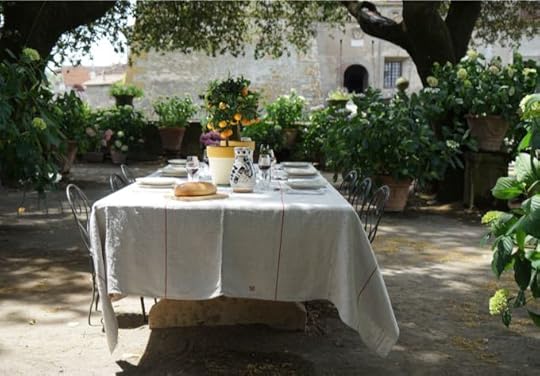
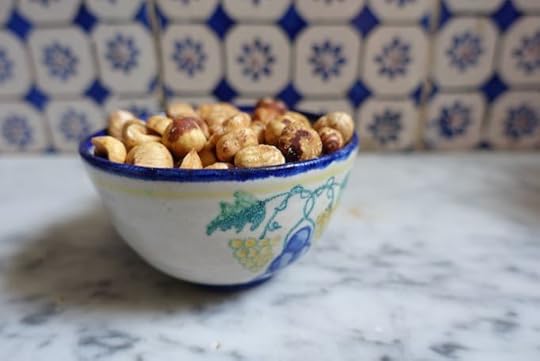
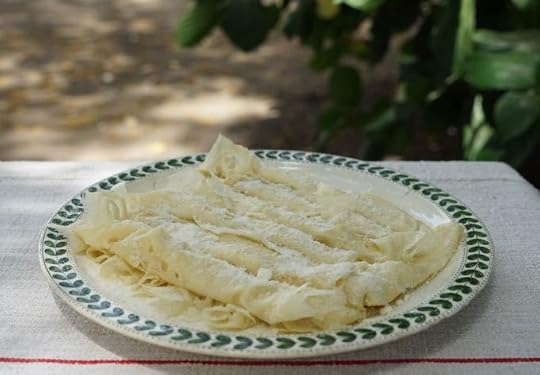
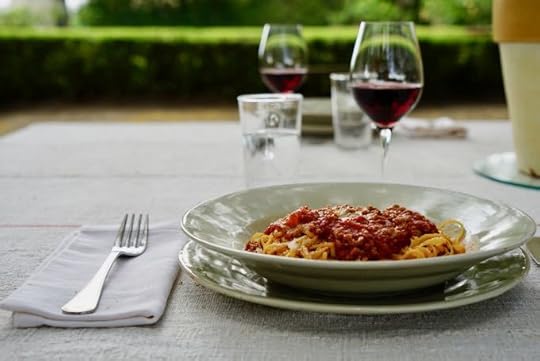
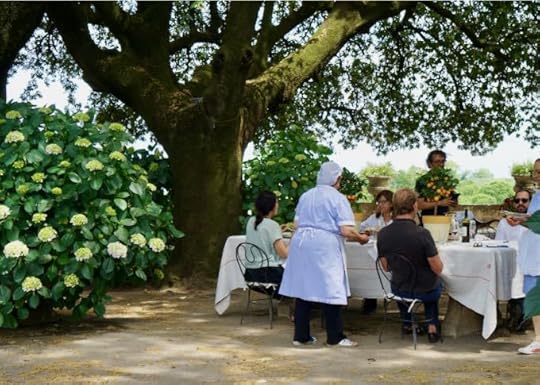
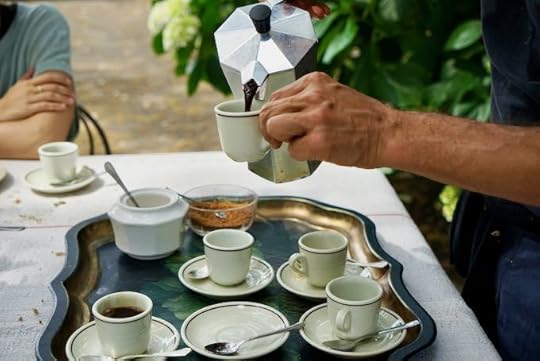
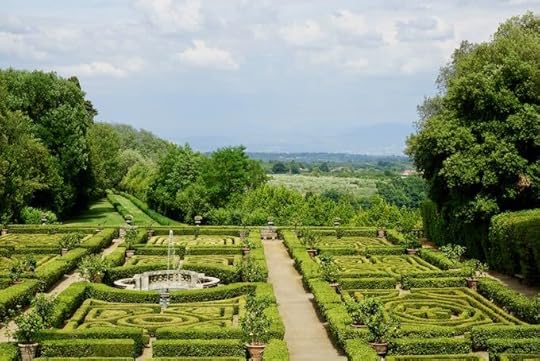
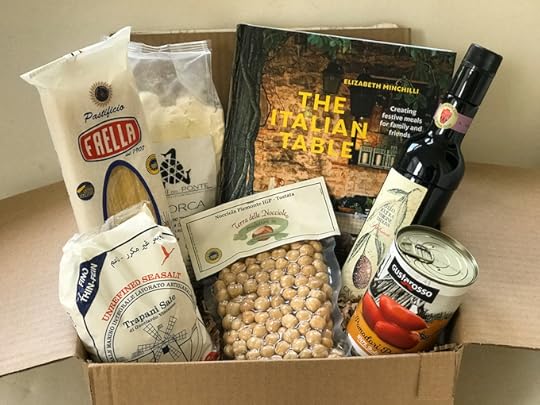
click here to order
The post Italian Table Gift Box appeared first on Elizabeth Minchilli.


November 18, 2019
Guest Post: Fennel Parmigiana
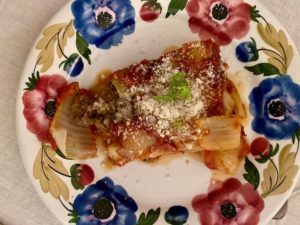
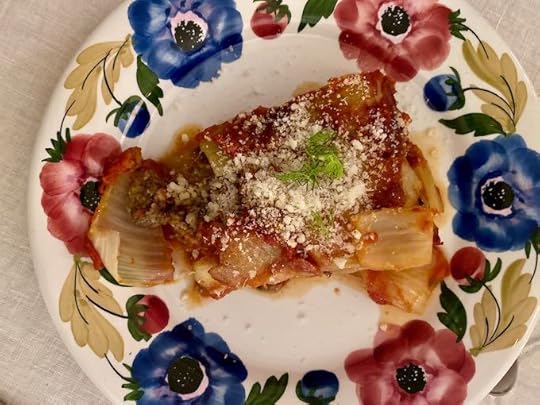
Here is a guest post from our favorite guest chef: Amanda Wotring
I’ve always thought of myself as a summer lover. Nothing makes me happier than lazy, sunny days and vibrant summer produce, but there comes a point around mid-July when I start longing for hearty fall and winter vegetables. Even on the hottest days of the year I crave braises, roasts and anything slow cooked that lends to a melt-in-your-mouth tenderness. Maybe it was the Vietnamese influence in my diet – never was it too hot or early in the day to have a steaming bowl of pho or spiced beef stew. Or maybe it’s the power of transformation that comes along with combining delicious ingredients in a roasting tray. Basically, anything that warms the belly has my vote.
Needless to say, I welcome the fall season here in Rome with open arms. When Elizabeth invited me to cook the welcome dinner for the Week Tour in Rome she hosted last week, I wanted to celebrate the seasonal produce of the month. We’d done several dinners in the past, focused on artichokes and pumpkin, so this time I decided it was fennel’s turn. I didn’t grow up eating much fennel, but when I first moved to Italy over fifteen years ago and first had the classic fennel, orange and olive salad, I fell in love. Now, I’m obsessed with fennel in any fashion. Boiled, raw, braised, made into fresh pressed juices, soups or teas, the fibrous-aniseed bulb is so versatile.
A few years ago, I had tried a parmigiana di finocchio at a small trattoria in Rome. Layers of boiled fennel replaced the classic fried eggplant in the recipe. The fennel got covered in tomato sauce, Parmigiano Reggiano and mozzarella and then baked into a unique combination of flavors I had never experienced. This dish stayed with me for years and our upcoming dinner was the perfect excuse to recreate it.
I made a trial version and was mostly satisfied with the result, but there was still something missing, something to lift and transform the dish into something memorable. I tossed and turned for hours that night when it finally hit me – sausage (which is often the answer to so many of life’s questions) Porky, fatty sausage was just the addition the dish needed and based on the feedback from our guests, it was the perfect addition for a chilly autumn dinner in Rome. The luscious, boiled fennel contrasted with the tangy tomato sauce and was perfectly rounded out by the warmth of the sausage, making for a cheesy soul-warming bite.
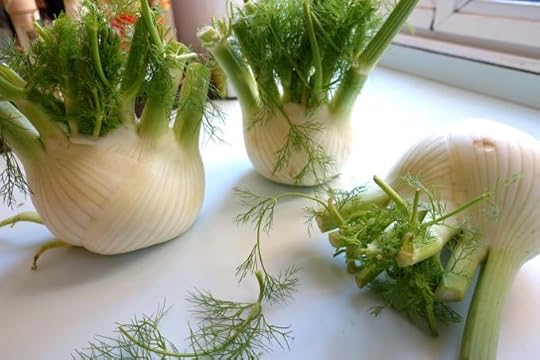

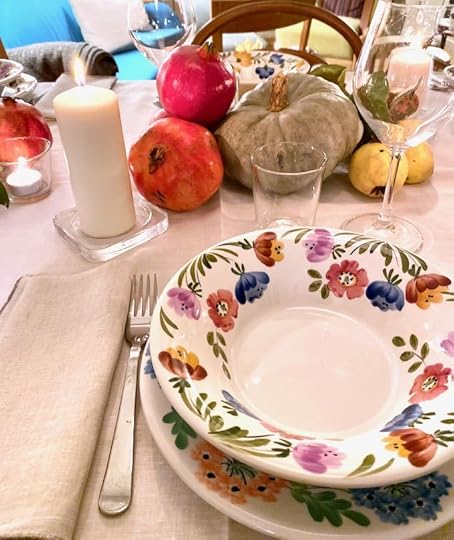

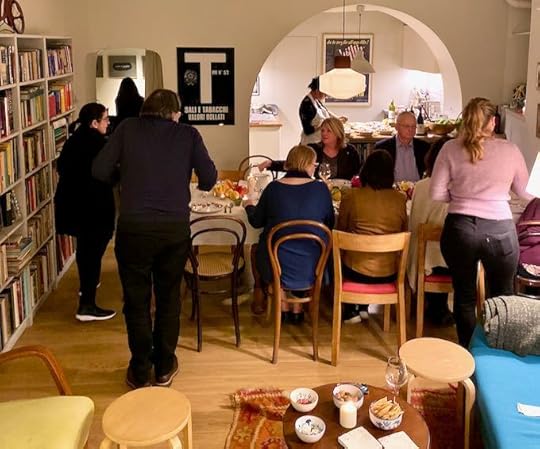
Fennel Parmigiana
Author Amanda Wotring
Yield 4
The sausages we used were made with orange zest and garlic, which were a great addition to the dish, but any other sausage will do (especially ones with fennel seeds!)
Ingredients
4 fennel bulbs, discard any damaged outer layers, but leave bulbs whole
3 sausages (about 1 pound/ 500 grams)
6 cups tomato puree
200 grams / 2 oz Parmigiano Reggiano, grated
1 pound / 1/2 kilo fresh mozzarella
1 medium onion, halved and peeled
Olive oil
Instructions
Cut mozzarella into 1/2 inch cubes and allow to drain in a colander while preparing recipePlace fennel bulbs (whole) into a large pot and cover with cold, salted water by 1-2 inches and bring water to a boil
Once the water boils, lower and simmer until fennel is tender (should take 45-60 mins from when flame is first turned on), fennel should be cooked through but not mushy, remove from water and allow to drain and cool in a colander
While the fennel cools, cover the bottom of a large sauce pan with olive oil and turn heat to medium-high
Brown onion halves in oil on each side, once browned add tomatoes. Add 1/2 teaspoon salt, and freshly ground black pepper
Reduce heat to simmer and allow to cook for around 45 minutes, or until sauce is reduced and thick. Remove onion halves from sauce (you can use onion pieces in parmigiana if desired, I did not)
Once fennel bulbs are cooled, carefully take apart the bulbs, gently removing each layer, trying to keep each piece intact and place on paper towel to allow to continue drainingRemove sausage from casing and break into large chunks, brown sausage in a pan and allow to drain on a paper-towel lined plate
Preheat oven to 200oC/ 400 F
In a 9×13 roasting pan, add a thin layer of tomato sauce, followed by one layer of fennel pieces, more tomato sauce, a couple handfuls of Parmigiano Reggiano, followed by sausage and mozzarella cubes
Continue for two more layers, omitting the sausage on the last and final layer Place on center rack of oven and roast for 40 minutes, or until top is slightly brownedAllow to rest for 15 minutes before serving
This dish can be made ahead and reheated.
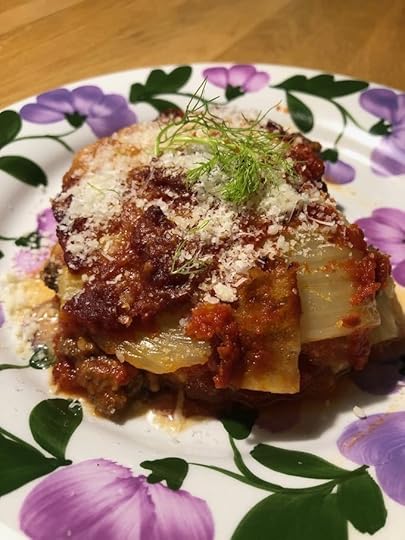
Follow Amanda to see what she’s cooking up.
For more about cooking in Italy and planning your own Italian dinner party see Elizabeth’s most recent book The Italian Table.
If you’d like to join Elizabeth and Sophie on a delicious week in Italy click here to find out more.
The post Guest Post: Fennel Parmigiana appeared first on Elizabeth Minchilli.


November 8, 2019
Puglia with Melissa Clark
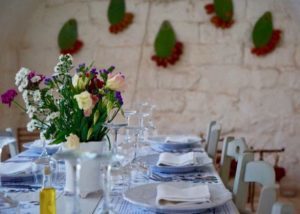
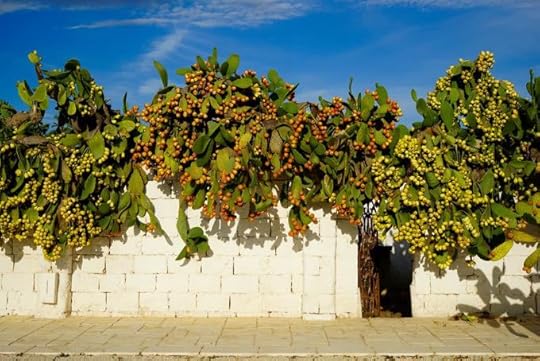
One of the constants in my work for the past 30 years has been the joy of meeting new people. Since I work for myself, and my career has shifted from art historian to journalist to writer to food tour creator to app writer I’ve had the great opportunity to get to know so many people from all walks of life. While many of the people I’ve met over the years have slipped away to only memories, a few have become great friends.
It’s not surprising that many of my best friends are writers, and that (no surprise here) they write about food. And like me, they like to travel. The best part of these friendships is when we also get the chance to work together. If, in fact, you can call traveling around Italy, eating and cooking non-stop, work?
I first met Melissa Clark (she of New York Times fame and author of 40 cookbooks) on a limoncello and pizza-fuelled trip along the Amalfi coast about 25 years ago. We’ve since traveled all over Italy together, from Piedmont to Sicily, and have had the great good luck to organize 2 food tours in Rome. We’ve now decided to take our show on the road and have booked ourselves into two of our favorite hotels in Puglia next September. To eat and drink and cook, of course.
Would you like to join us?
We will be starting our week in what has been described as one of the most magical hotels in Italy. The tranquil 16th-century Masseria Potenti (which is featured in my book The Italian Table) is tucked into a wild and sparsely populated region of Puglia. After walking through the white-washed archway, the massive enclosed courtyard gives way to shady vine-topped pergolas, roughhewn arched passageways and walls full of brilliant bougainvillea and bright orange prickly pears. We will spend 3 days here, cooking with Melissa and the owner Maria Grazia, as well as visiting towns like Gallipoli to eat fish and Grottaglie to explore ceramics.
We then move to the other coast, staying in the dreamy Don Ferrante hotel, located in Monopoli. This tiny fishing village centers on the port, where boats still come in every evening, laden with fish. Our luxurious boutique hotel is built into the walls that protect the village from the sea. From our base in Monopoli we’ll visit the Unesco protected town of Alberobello, as well as the small village of Cisternino, knowns for its culinary traditions.
Details of Melissa Clark in Puglia Food Tour:
When: September 14 to September 19, 2020 (5 nights)
Who: The trip is limited to 16 people
Where: We start our week at Masseria Potenti (near Manduria, Puglia) and end our week in Monopoli, Puglia
Nearest airport & train station: Bari
What: The days will be full, with adventures both in and out of our hotels. But don’t worry, you’ll have some down time as well, to relax.
Some of the things we’ll be doing:
Cooking class with Melissa
Pizza night with Melissa
Visit to fish market of Gallipoli
Visit to Olive Oil Plantation and Mill
Visit to local Ceramic Studio
Visits to Alberobello, Cisternino, Grottaglie, Gallipoli and Ceglie Messapica
Wine tasting
LOTS of burrata and mozzarella eating
There is lots more of course, and if you’d like to hear about the details, just send me an email. The trip is filling up fast (I announced it first in my newsletter last week) , but we still have a few spaces left. Hope you can join us!!
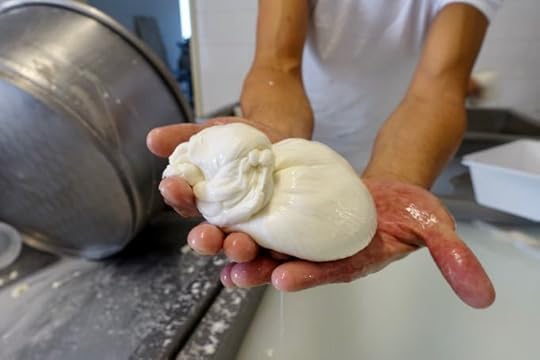
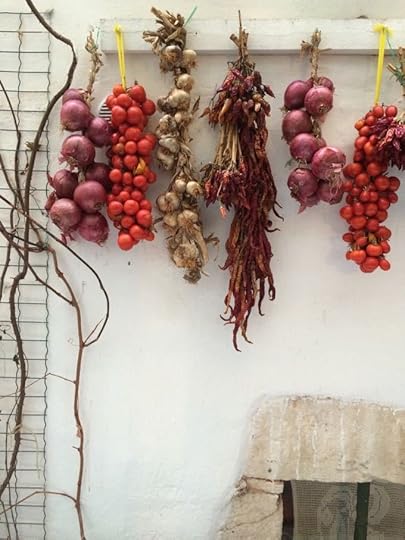
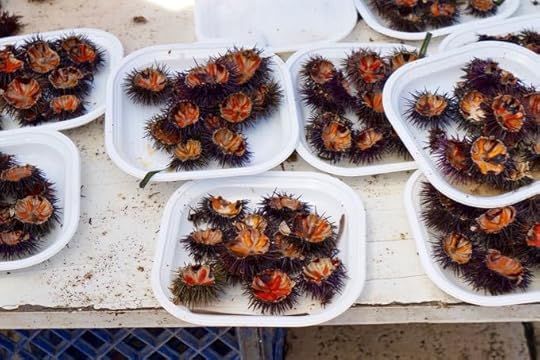
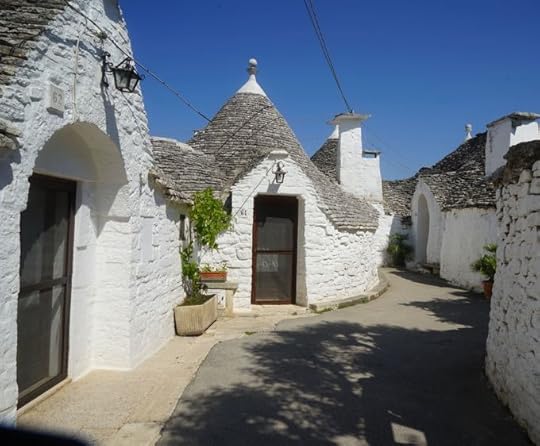
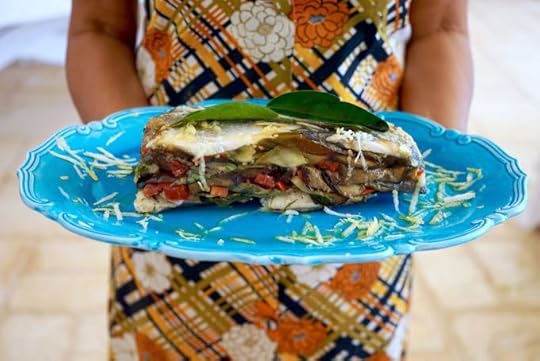
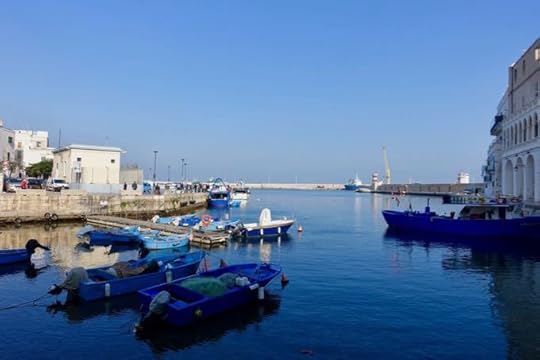
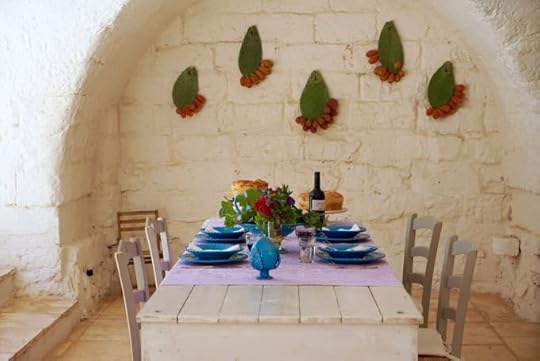
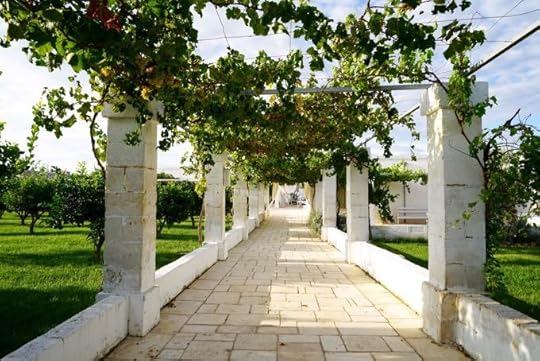
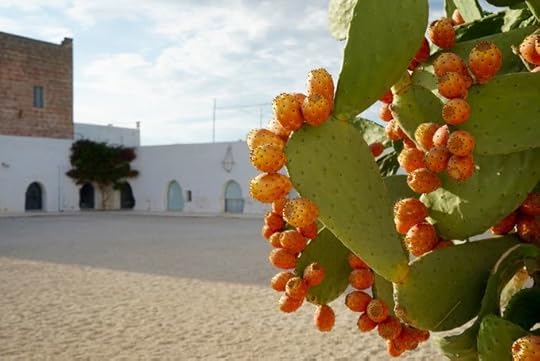
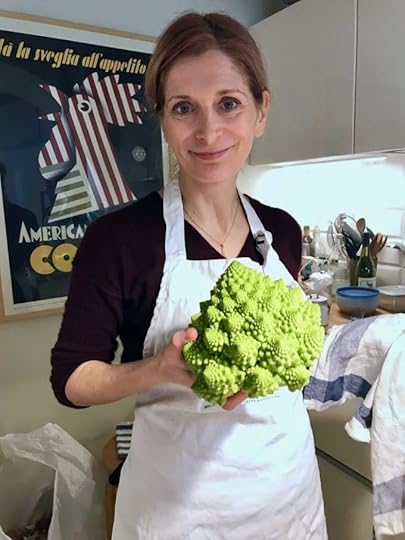
The post Puglia with Melissa Clark appeared first on Elizabeth Minchilli.


October 28, 2019
savory ricotta crostata
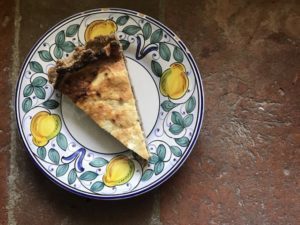
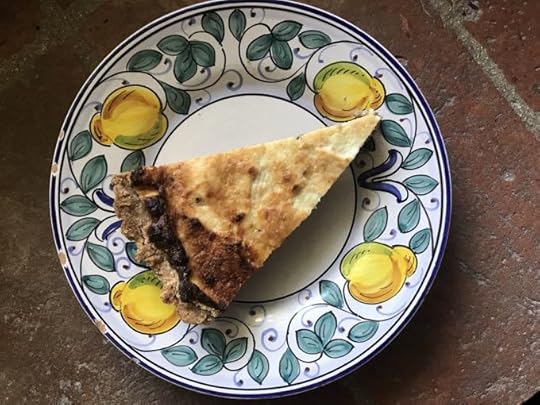
I’ve been wanting to make a savory ricotta crostata for a long time. My sweet version has been my go-to dessert for about the last 15 years. The recipe, in all its variations, has appeared in my books Eating Rome, Eating My Way Through Italy and The Italian Table as well as on my blog here, here and here. Melissa Clark even wrote about my crostata in the New York Times. But the idea of a savory version, was always buzzing around my head.
The thing is, I wanted the savory crostata to have all the qualities that I love about my sweet crostata, including the buttery, shortbread-like, crust. The filling also had to be similar and I was very sure I didn’t want it to be too eggy (like a quiche) or too vegetabley (like a torta rustica). The main question was that I wasn’t quite sure what would replace the fruit jam that was the basis of all my crostatas.
I finally found my inspiration the other day while at our friend’s restaurant Il Ceretto
The area around Cannara, where Il Ceretto is located, is known for its incredibly sweet onions. And Doriana, the matriarch and in-house chef of both the family restaurant and agriturismo, makes and packages a delicious jam made from these very onions. Barely sweet, and very oniony, it’s a bit like a smooth chutney. They often serve it alongside the pecorino cheese that also comes from their farm.
Once I’d found my jam, the rest came together quickly. I often make a sweet crostata with ricotta, mixing in a bit of sugar and chunks of chocolate and/or berries. So I decided to top the onion jam with a thick layer of ricotta enriched with grated parmigiano and pecorino.
For the crust I made do with much less sugar than I usually use, and instead added chopped walnuts. I also decided to use stone ground whole wheat flour, to rustic the whole thing up.
It turned out as delicious as I thought it would. I served it as part of a buffet for our guests at one of the dinners we had last week during our Week in Umbria tour, as main course. But I’m thinking that it will make a perfect antipasto, served along with a salad on the side. I also think that by cutting it into tiny squares it would work well with drinks, for aperitivo.
Another thing I’ll be doing is playing around with the jam layer. I have a jar of hot pepper jam in the pantry that I think will work perfectly. And I’m definitely going to try using almonds or hazelnuts in place of the walnuts. Now that I’ve broken the savory crostata code, the possibilities seem endless.
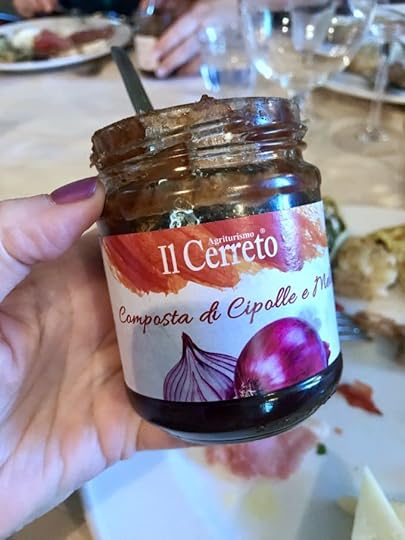
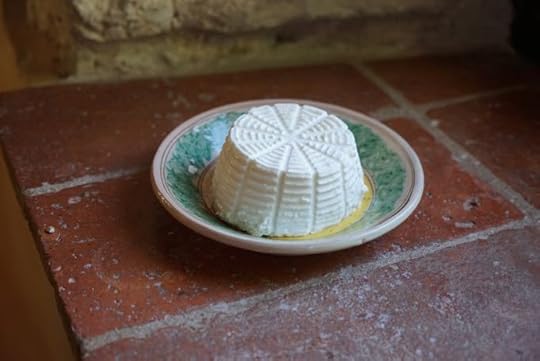
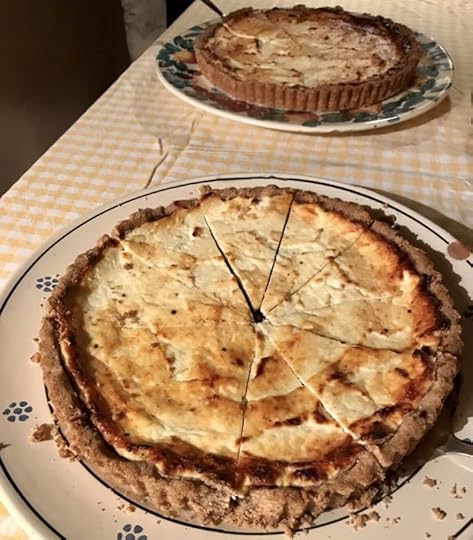
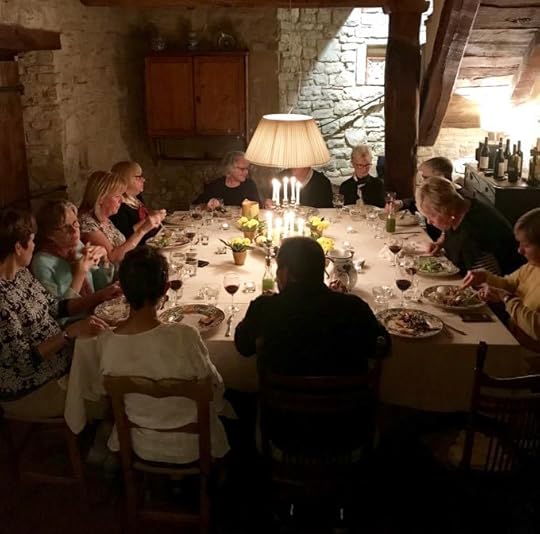
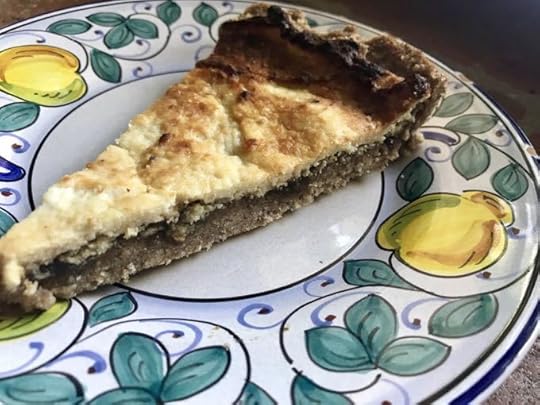
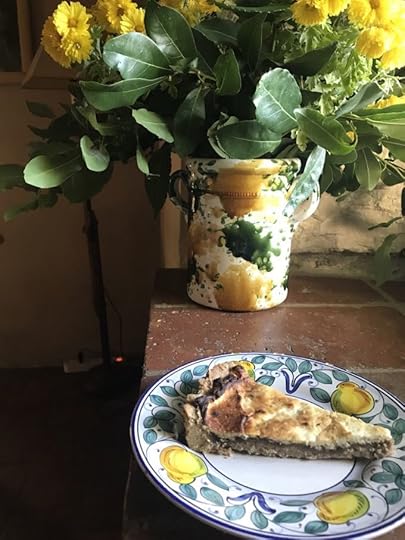
Prep 20 mins
Cook 45 mins
Inactive 1 hour
Total 2 hours, 5 mins
Yield 8-12
I used an onion jam made by Ceretto for this tart. You can order their jam from their somewhat wonky Italian website here. There are tons of recipes out there to make your own, if you feel inclined. Or experiment with another kind of jam (hot pepper, bell pepper) or even chutney. If the chutney seems too chunky, then just put it in the blender.
Ingredients
1 1/2 cups whole wheat flour
1 cup walnuts
2 tablespoons ice water
1/4 cup sugar
1 teaspoon salt
6 tablespoons butter (115 grams) cold, cut into pieces
1 cup onion jam
1 1/2 cups of ricotta
1/2 cup of grated parmigian0 reggiano
1/4 cup grated pecorino
1 teaspoon freshly grated black pepper
1 medium egg
Instructions
Place the walnuts in the food processor and process until sand like. You don’t want paste.
Add the flour, salt and sugar and spin a few times to mix well.
Add the butter and process until it is mixed in, and the butter is the size of small peas.
With the motor running, add the water slowly, and mix until the dough starts to clump together. If it seems not to be coming together, then just put it on a work surface and work it with your hands until it holds together.
Flatten into a disk, cover with plastic wrap and place in refrigerator for an hour.
Preheat oven to 350F/ 180 C
Line a tart pan with a removable bottom with parchment. Butter the sides.
Take the dough out of the fridge and place it on a floured surface. With a rolling pin, try to roll the dough out a bit. It’s a very fragile dough, so don’t freak out if it starts to fall apart. Just lift it up and plop it in the pan. Don’t worry if it comes to pieces. Just spread it out evenly using the palm of your hand. It’s a bit like play dough and will patch together. Make sure it comes up the sides to form the crust because that is the best part!
Once the dough is in the pan, spread the jam over the bottom to form a thin layer. You really don’t want too much. About a 1/4 inch max. Even less. Just a slick of jam.
Next put the ricotta in a bowl, along with the grated cheeses, black pepper and egg. Whisk with a fork until smooth.
Using a spoon, plop the cheese on top of the jam layer. Then, using an offset spatula or big butter knife, gently spread the ricotta to cover the jam layer. You have to be careful and gentle, since you don’t want to mix the jam into the ricotta layer. Smooth it out.
Place in oven and bake for about 40 to 45 minutes, until the ricotta starts to turn golden.
Remove from oven and let cool completely. Carefully remove the rim from the baking pan, and place on serving platter. I usually leave the disk base of the pan in place, since the tart is so fragile.
Cut into 8 to 12 slices, depending on how big you want your portions.
I served this tart during a dinner at my home in Umbria, as part of our Week in Umbria food tour. If you’d like to learn more about my tours and join us, see this page, or send me an email to receive all the details.
For more recipes to make your own Italian meal, see my book The Italian Table.
The post savory ricotta crostata appeared first on Elizabeth Minchilli.


September 13, 2019
sgroppino – lemon sorbet
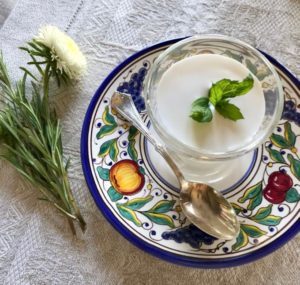
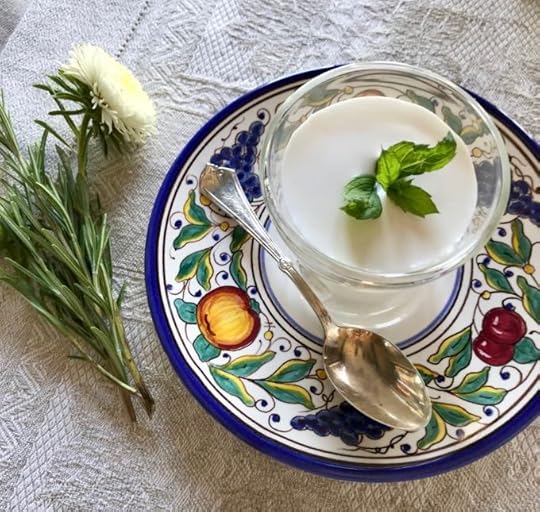
The other day I stopped by my friend Laura’s for lunch. As always it’s never just a ‘come over and I’ll make us a sandwich’ kind of meal at Laura’s. The table is always set to perfection and the food – cooked by the uber-talented Paola – is always to die for.
After a quick drive around the property with Jim to see the new winery they are building, we sat down to this drop dead gorgeous and delicious lunch.
Crostini with Pancetta & Sage – Rose 420
Fettucine with Goose Ragu – Rosso 420
Deep Fried Rabbit
Fried Potatoes with Home made Ketchup
Salad from the garden
Sgroppino
Most of the purpose of this post is just to share these pretty pictures.(And for more pretty pictures of this home see my book Italian Rustic) But I also wanted to leave you with at least a little something you could easily whip up at home in case you had photo envy.
I’m not expecting you to try to find a rabbit and deep fry it (although both you and I would be very happy if you did). I’m not even going to ask you to try to track down a goose so you could make that fabulous ragu. Instead, I’m hand delivering the easiest dessert in the world to you: Sgroppino.
Every home cook should have this recipe in their back pocket since it’s
Everyone loves it
It’s dead easy
Look how pretty and impressive it can look if you try!
This is a dessert that is traditionally served in fish restaurants after the meal as a way to cleanse the pallet. Although in theory it’s a kind of pre-dessert, most people just stop there after a large feast. Served in a tiny cup, it’s the perfect amount and not too sweet. As long as you can get your hands on good lemon sorbet (by all means make your own, but really why bother?) the rest is easy. And if you’re wondering why not just serve plain old lemon sorbet? Because the other 2 ingredients are prosecco and vodka, that’s why.
And if you’ve finished reading this post and are wondering ‘hey, what about that Crostini with Pancetta and Sage?’ It was AMAZING! Brilliant idea that is barely a recipe. Cut up pancetta into little logs, saute till crisp throwing in some cut up fresh sage at the end. Pile it on top of small pieces of bread which you’ve toasted in the oven with a bit of olive oil. And if it just seems like an excuse to eat pancetta that’s because it is.
And to answer your other question: her name is Gracie and she spent most of the time on my lap.
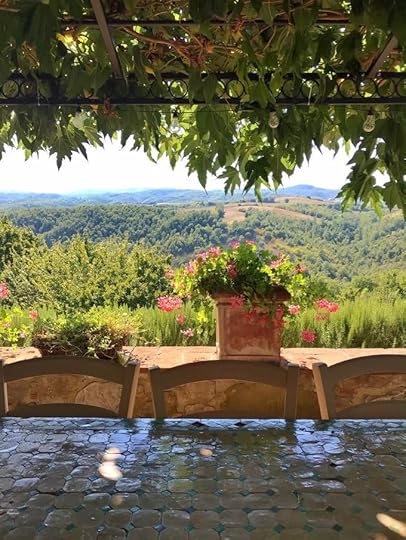
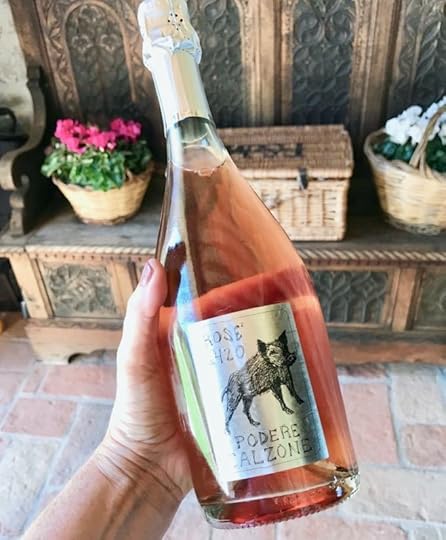
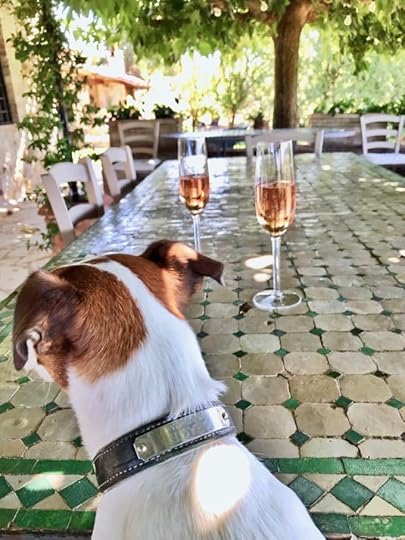
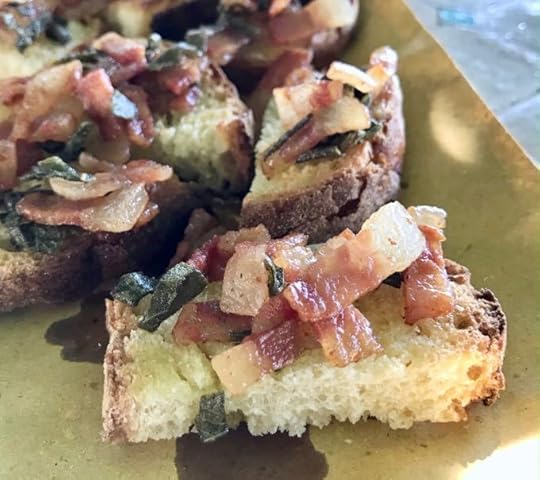
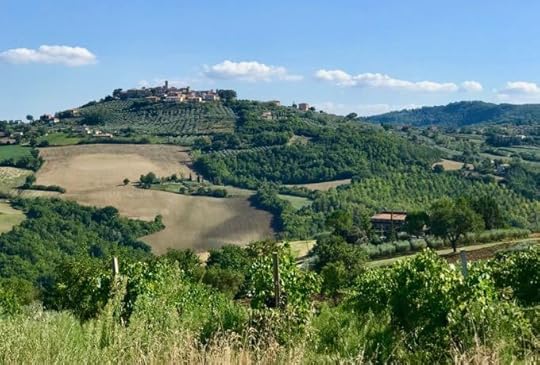
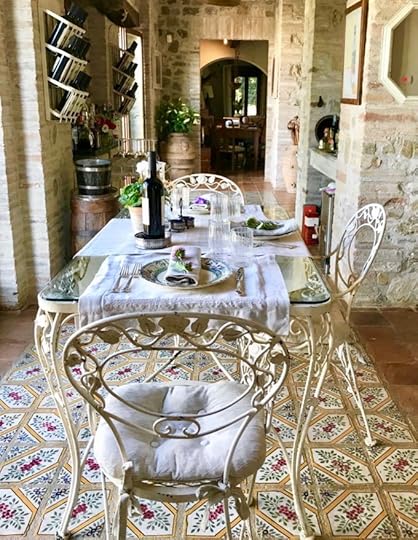
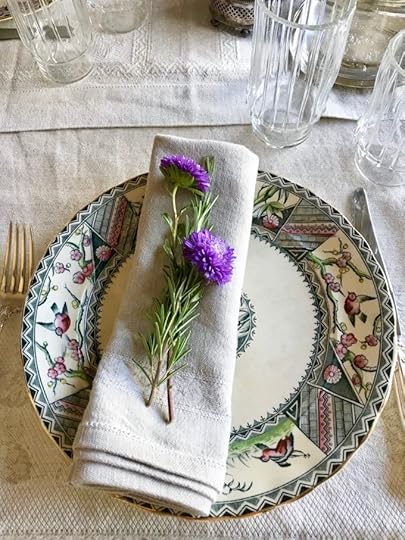
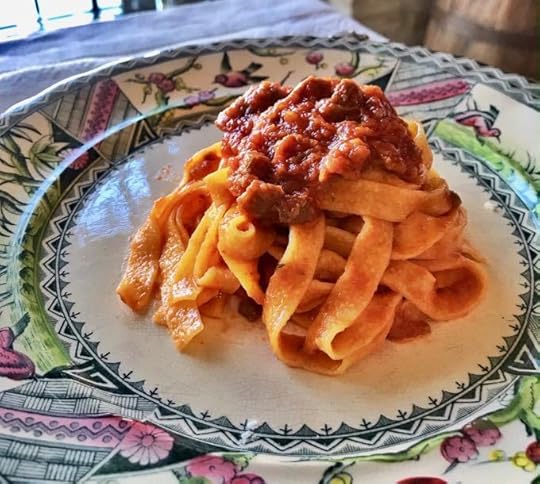
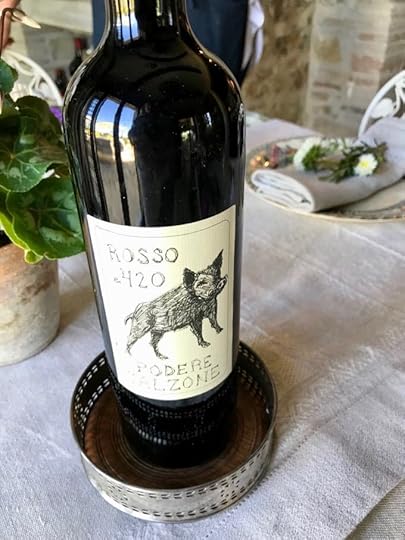
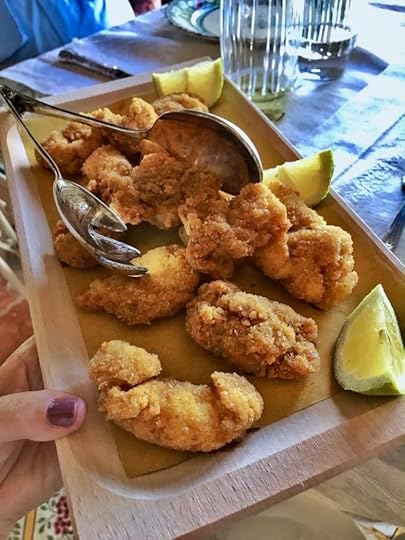
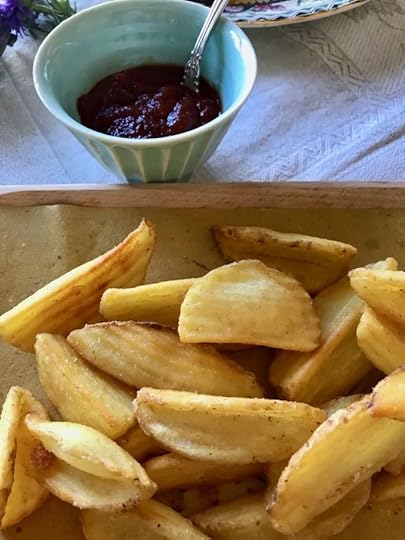

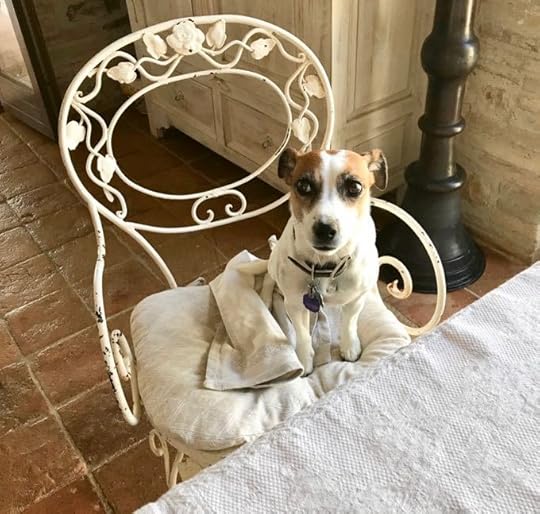
Sgroppino – Lemon Sorbet
Prep 3 mins
Total 3 mins
Yield 1
The following is a recipe comes from my book The Italian Table. The recipe for 1 person. Simply multiply for more, but you should make no more that a six-serving batch at a time, or else the sorbet will begin to melt too much.
Ingredients
1⁄3 cup high quality lemon sorbet
3 ounces prosecco
1 ounce vodka (it helps if the vodka is ice cold, from the freezer
Instructions
If your freezer is super cold and your sorbet is frozen solid, let it rest at room temperature for about 20 minutes before beginning.
Measure out the sorbet into a large stainless steel bowl. Add a splash of prosecco and whisk the sorbet until it becomes slushy and the prosecco is mixed in. Slowly pour in the vodka, while continuing to whisk. Then add in the rest of the prosecco, stirring to mix.
Pour into glasses and serve immediately (it will start to separate as it rests). It should be liquid enough to sip, so you shouldn’t need a spoon. It’s traditionally served in champagne flutes
The recipe for Sgroppino comes from my book The Italian Table: Creating Festive Meals for Family and Friends. If you’d like to create your own Italian feast this is the book for you.
If you’re more adventurous, and would like to join me for a meal like this in Umbria, you can. Just send me an email and I’ll tell you all about our Week in Umbria tours for 2020.
The post sgroppino – lemon sorbet appeared first on Elizabeth Minchilli.


September 10, 2019
Week in Sicily Tour
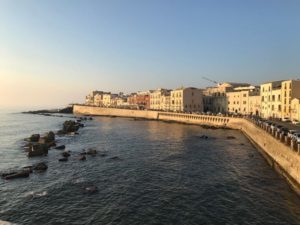
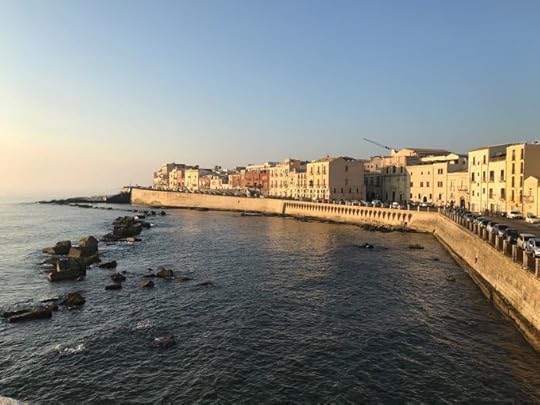
Although I live in Rome and Umbria, I’ve been visiting Sicily regularly since I was 12. From the first time I visited, during a Christmas vacation with my parents tumbling around in the back of Fiat 124 with my sisters, I loved it.
I’ve since have returned as a tourist , reported on it for magazine articles, shot videos that went viral, written too many blog posts to count and of course researched my last two books.
Now I would like to share some of my favorite places with you.
I returned to Sicily several times this year to plan our newest tour: A Week in Sicily. Planning the trip gave me the chance to dig even deeper into a region that I’m passionate about. The most difficult part of planning the itinerary was that there is just so much to include. Sicily is BIG! While a lot of other tours of Sicily try to drive all over the island, going in a circle and changing hotels several times, I’ve made a completely different choice.
We will be based in one of my favorite towns, the completely enchanting Ortigia, the entire time. From there we will take day trips to visit some of the most delicious spots on the island. We will explore olive oil, cheese, wine, granita, pastries, bread, fish, focaccia as well as get a chance to dive deeply into the unique Baroque architecture of towns including Ragusa, Modica and Noto. There will also be a volcano visit in case you were wondering.
There has been a lot of talk about over tourism lately, and it’s opposite, Slow Tourism. It’s the slow approach that attracts me. I think staying put in one hotel in one town gives you a chance to get a much more intimate experience. The places we’ll be visiting are not the usual bucket lists items. We’ll be spending time with friends and colleagues who are as passionate about the traditional ways of living and eating as we are. We will visit their wineries, farms and homes learning about a different side of Sicilian life.
Our first Week in Sicily will take place March 29 – April 4, 2020. If you’d like to receive details send me an email. I have a feeling the tour will fill up fast. It’s actually actually already half full, since I announced it first on my newsletter 3 days ago, and the response has been fantastic (readers of my newsletter always get the first chance to join us). If all goes well, we will certainly be making this a yearly (or twice yearly) trip!
Where: Ortigia, Sicily
When: March 29 – April 4, 2020
What: Food focussed tour of my favorite spots along the East end of Sicily
How: Send me an email and I’ll send you the details
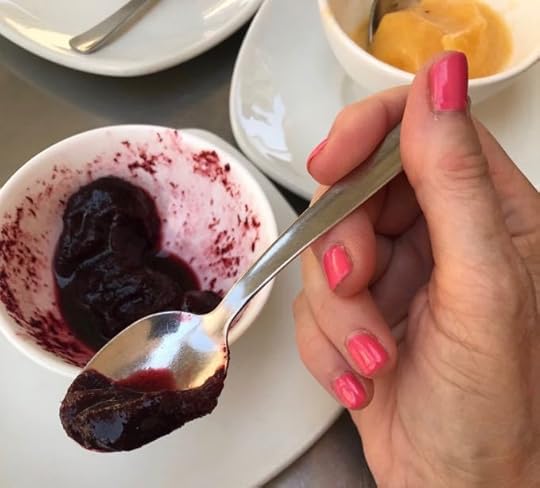
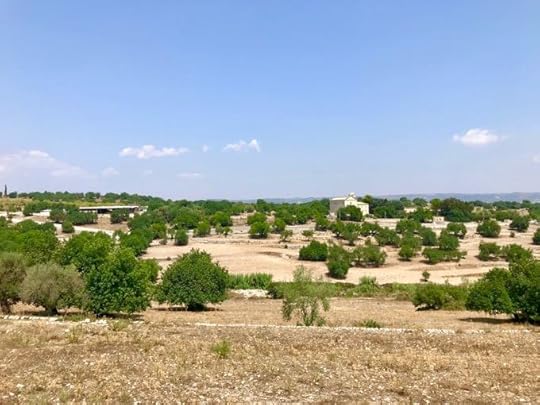
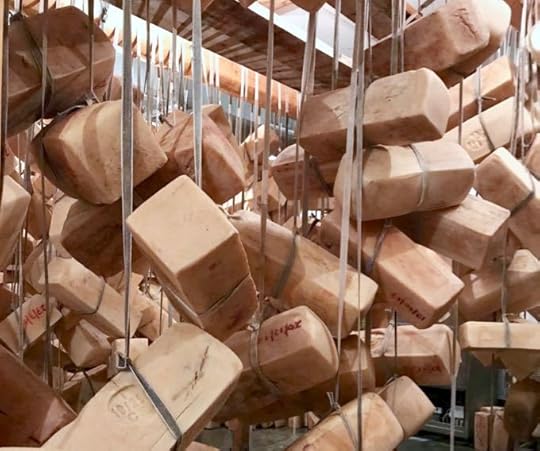
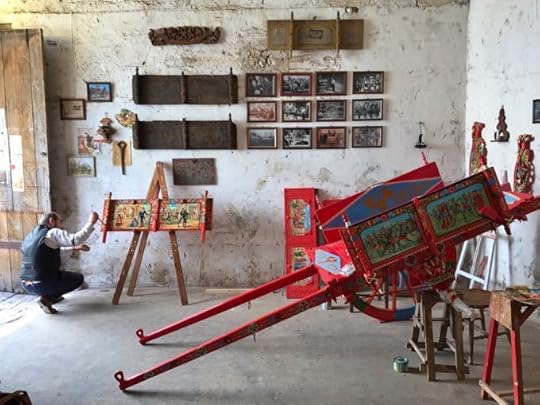
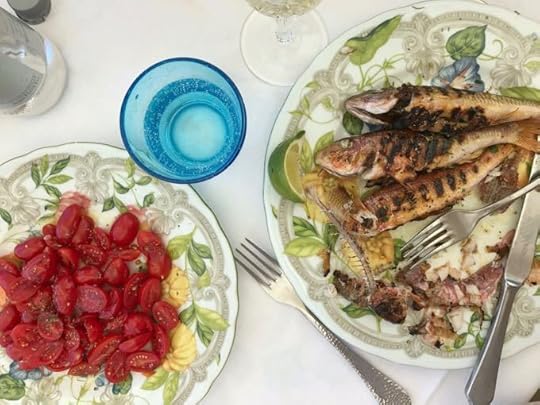
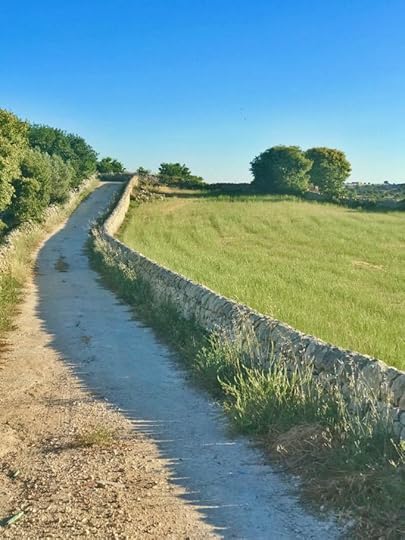
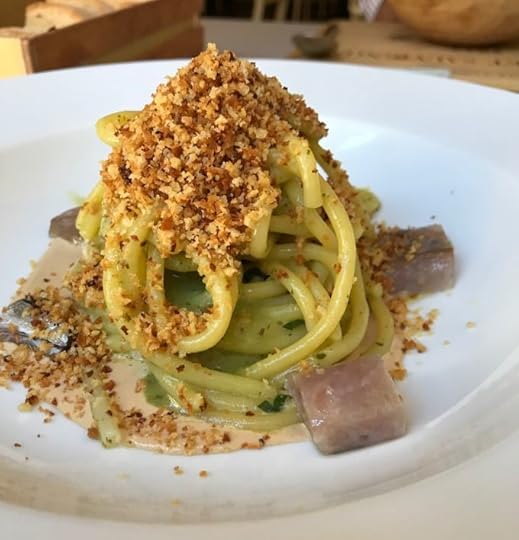
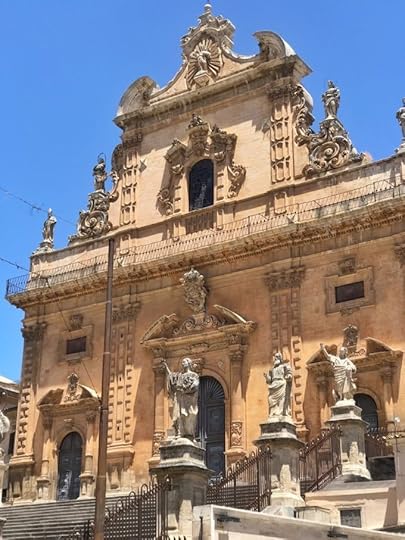
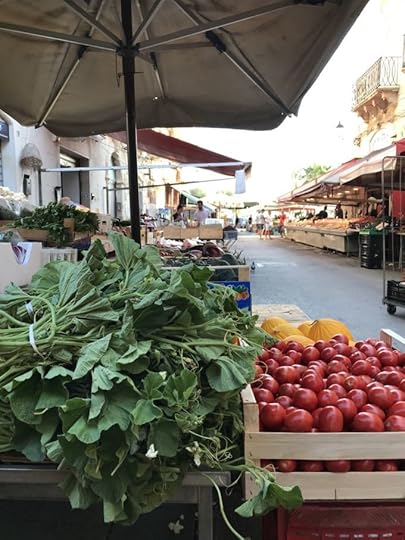
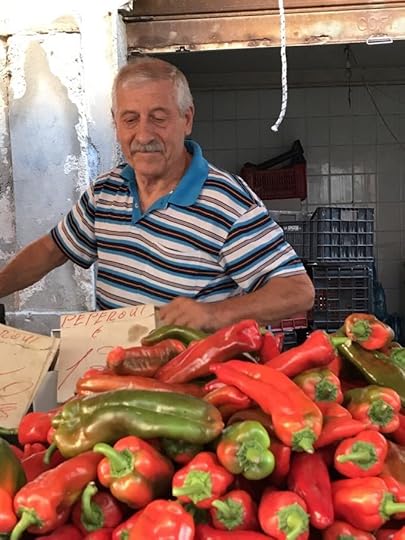
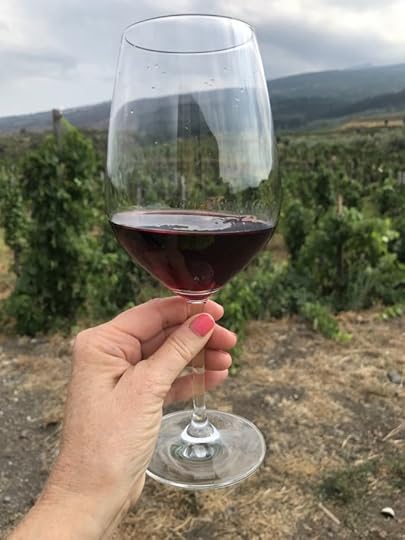
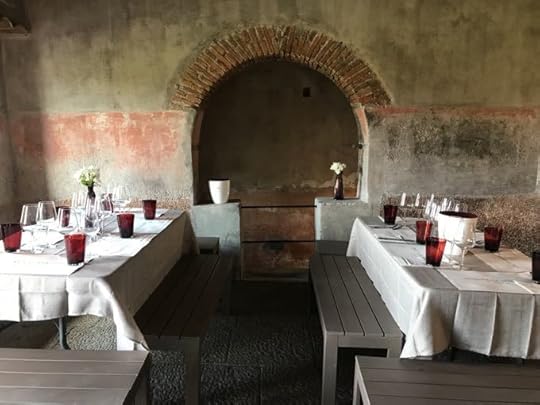
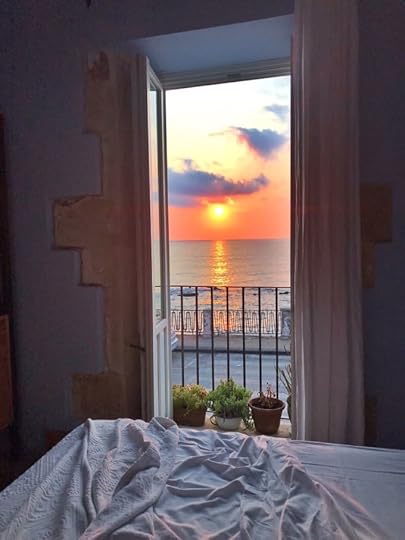
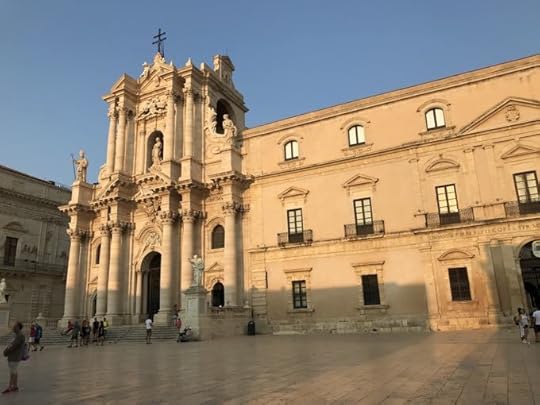
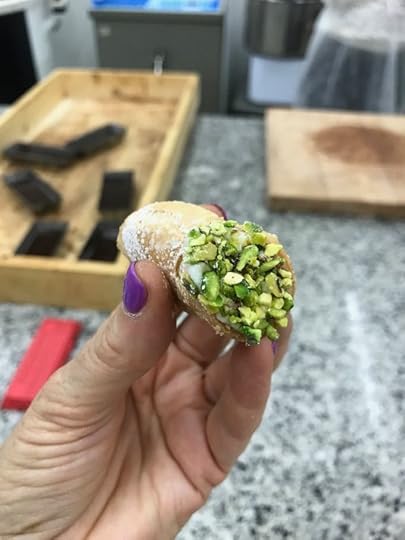
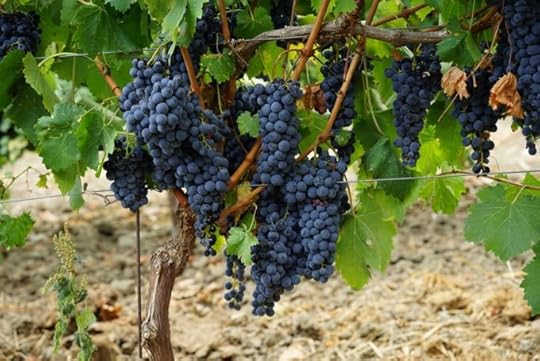
For more on eating in Italy please download my app Eat Italy, available for both iTunes and Android. My most recent book, The Italian Table , has an entire Sicilian menu that you can make at home. And my book Eating My Way Through Italy has three chapters on Sicily.
The post Week in Sicily Tour appeared first on Elizabeth Minchilli.


August 23, 2019
arista – florentine pork roast
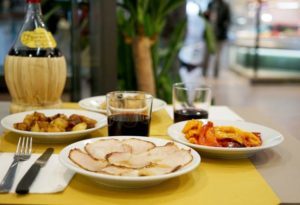
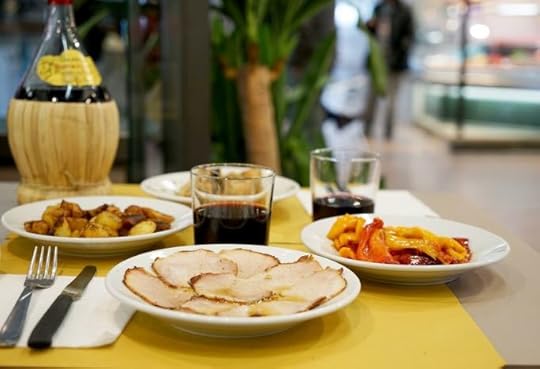
One of the cookbooks I’ve been cooking from this summer is my own. Since this summer I don’t have to develop new recipes for a new book, it’s pure pleasure to turn to a recipe I know works and that I know is good. And that just happens to be mine.
Actually I can’t lay claim to this classic recipe. Arista is a Florentine classic that every Tuscan can cook in their sleep. But me? I’d only ever eaten it in restaurants (enjoying it for sure) but had never attempted it at home. Roast meat in general is something that I’ve come late to in life. I’m more likely, when faced with meat, to cut it up and saute it in some way or another.
While I do make this pork roast every so often, I actually prefer arista. One thing it has going for it is that you make it ahead of time and heat it up right before you serve it. So it’s the perfect dinner party fare. I usually make bean soup first (another make-ahead dish) and that way I can enjoy a cocktail before dinner in the garden with my guests, instead of sweating away in the kitchen.
Also? Because you wait to carve it once it’s cooled off, you are able to form super thin slices that are sure to impress everyone.
The natural side dish with Arista is roasted potatoes. Due to copy editing cuts and space restrictions, the recipe got cut from the book. But that’s ok, since you can find my favorite roast potato recipe here.
I also usually serve sauteed or roasted peppers with this roast. Not only does the sweetness of the peppers go well with the salty fatty pork, they also add a spot of color to an otherwise kind of beige meal.
Arista – Florentine Pork Roast
Prep 15 hours
Cook 1 hour, 15 mins
Inactive 2 hours
Total 18 hours, 15 mins
Yield 4-5
I think there may be a law that says that every restaurant in Florence must serve Arista’. While it may look simple, there are several keys to ensuring yours is as good as those served in Florence. Make sure you thoroughly season your roast. When in doubt, add more salt. And definitely let the outside brown well in the oven. Arista is always served sliced very thinly and to accomplish this you really have to let the roast cool off completely before slicing.
Ingredients
12 small branches of fresh rosemary
20 sage leaves
1 teaspoon of salt, plus more
3 cloves of garlic, peeled
1/2 teaspoon of freshly ground black pepper
2 tablespoons of extra virgin olive oil plus more
2 pound pork loin roast
1 cup white wine
Instructions
Preheat oven to 400
Strip the leaves off of six of the branches of rosemary. Place the rosemary, sage leaves, garlic, salt and pepper on a cutting board and chop very finely. When it is finely chopped, place in a small bowl and mix in the olive oil. (You can also do this in a mortar and pestle or else in a mini food processor).
Rinse your pork roast under cool water, and pat dry.
Place the roast on a level surface, and using a sharp knife, make small, but deep cuts all over the roast. About 15 to 20 cuts in all.
Using your fingers, stuff 2/3 of the mixture into the small holes. Rub the rest of the mixture onto the outside of the meat.
Now it’s time to tie up your roast. Place 3 rosemary sprigs on the top side of the roast, and 3 on the bottom. Using kitchen twine, tie up the roast evenly, from one end to the other, making sure to catch the rosemary sprigs on either side. Salt the roast well on all sides. (You can have your butcher do this for you, and make the slices around the roast, avoiding the string)
Choose a low-edged pan that is only a little bigger than the roast, and pour a bit of oil in to coat the bottom.
Place the roast in the hot oven and cook for 15 minutes. Then add one cup of white wine to the pan, and turn the oven temperature down to 350°F.
Continue to cook for an hour and 15 minutes, basting with the white wine and turning the roast so that it browns on all sides, about every 15 minutes.
Take the roast out of the oven and let cool completely, for at least 2 hours) before slicing. The slices should be very thin, about 1/2 cm or less.
Arrista is often served at room temperature, but to reheat, place the sliced arrista in the oven, covered, with some of the pan juices drizzled over it.
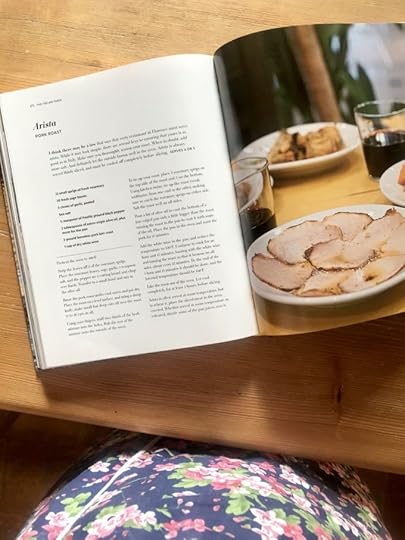
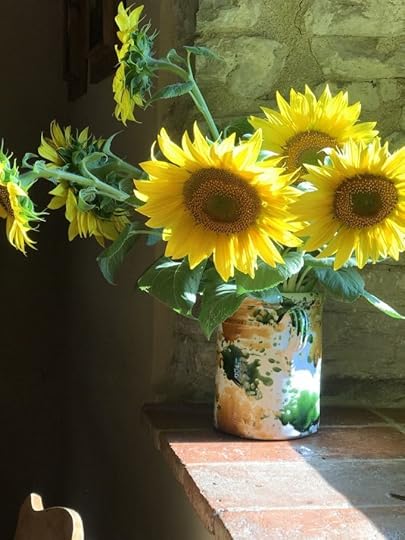
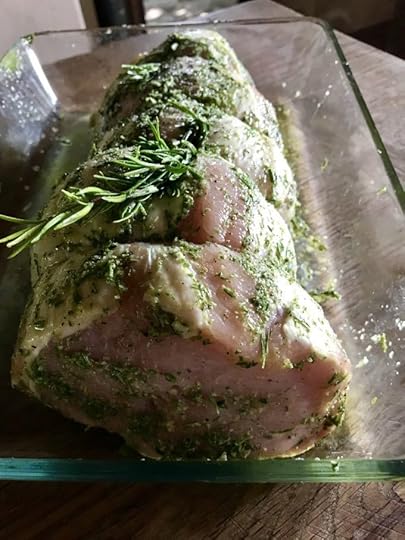
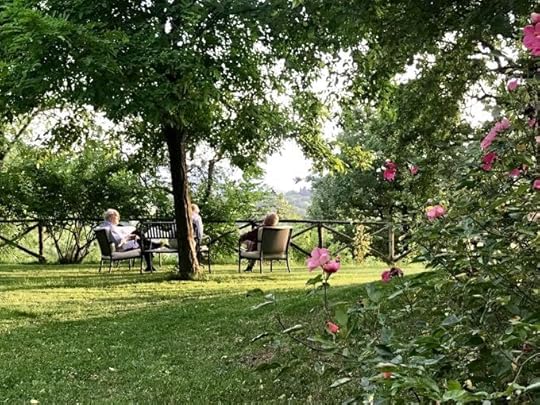
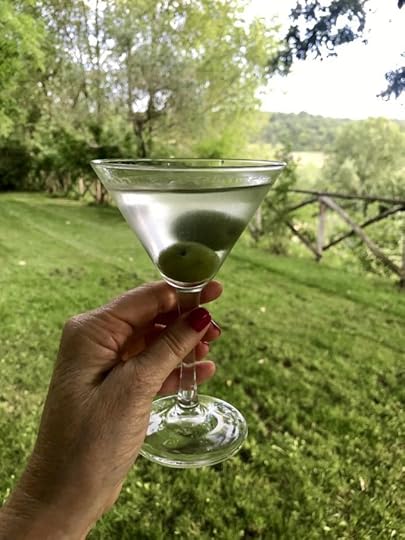
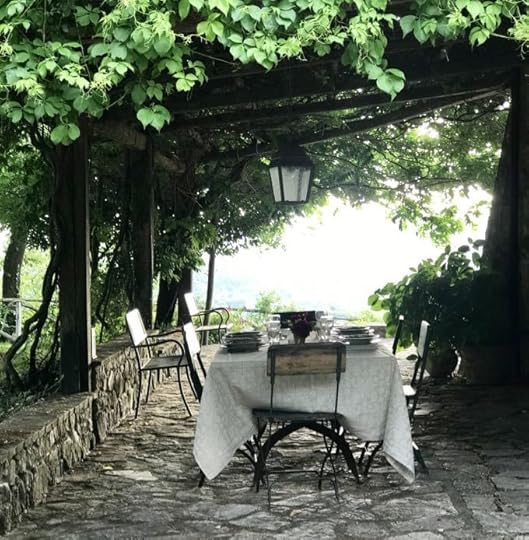
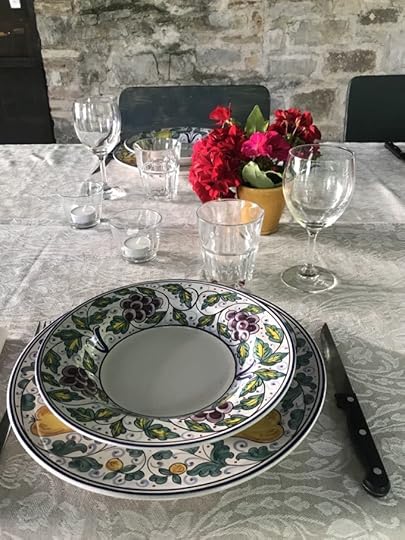
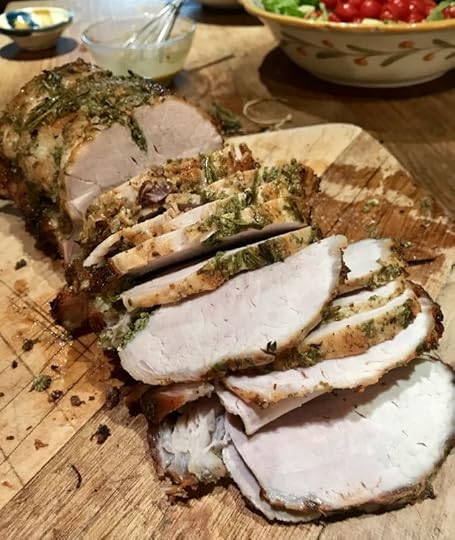
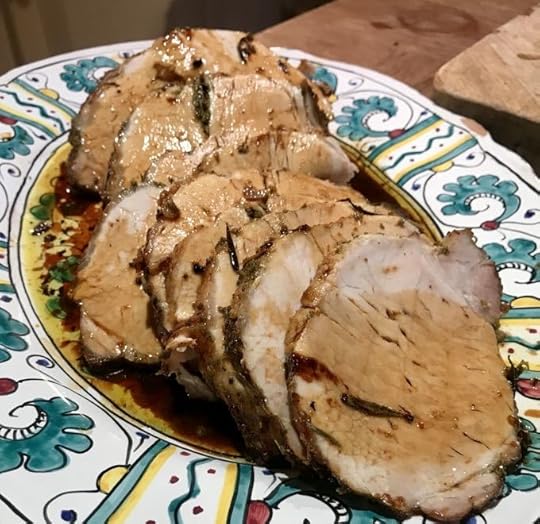
The above recipe is an excerpt from my new book The Italian Table: Creating Festive Feasts for Families and Friends. You can find it at your local bookstore or order it online from the usual sources found here.
For dining in Florence, and the rest of Italy, download my app EAT ITALY for iTunes or Android. And for more food advice see my books Eating Rome and Eating My Way Through Italy.
The post arista – florentine pork roast appeared first on Elizabeth Minchilli.


July 29, 2019
Puglia Beach Weekend
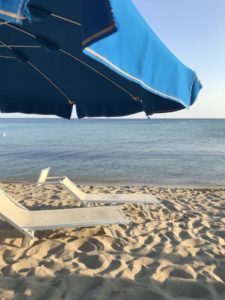
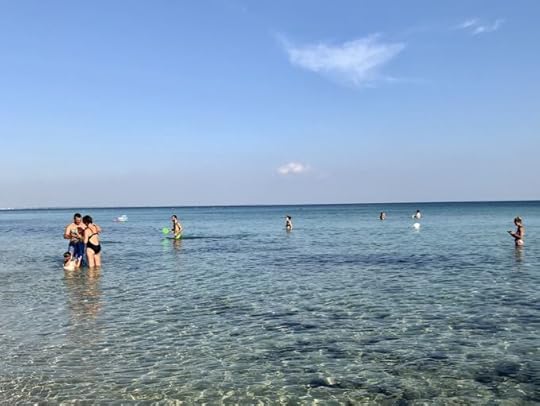
Lido degli Angeli, Punta Prosciutto
The weekend before our Week in Italy tour this past month we decided to take Puglia beach weekend. We used to go to the beach in Puglia every summer, when the girls were little. Way down at the tip of Puglia, we’d stay in an all-inclusive resort that was perfect for a family with both toddlers and grandparents. Somehow, once we stopped doing this, the whole Puglia-beach-family-vacation fell off the radar. Both girls plan their own trips now (being adults!) and Domenico and I usually manage a few days somewhere much nearer to Rome.
Since both Sophie and I needed to be in the area near where our tour started, early Monday morning (Manduria) that was my starting point when I started to research where to go. I also knew the beach called Punta Prosciutto was supposed to be gorgeous. (Actually, I knew that from Sophie’s Instagram!) Want to know how I found a place to stay? Just looked on google maps on this general area and started clicking on all the hotels and/or b&b’s.
I found a lot of sorry looking places.
This confirmed what I already knew: while Puglia is gorgeous and has great beaches, it’s hard to find some place really nice to stay. This is one of the most common questions both Sophie and receive: do you know of a cute little town, with great restaurants, near a nice beach, with great places to stay.
To answer the first question: there are lots of small towns, but most of them are not what you’d consider ‘cute.’ Yes, there are the well known cities and towns like Ostuni, Lecce, Monopoli, Gallipoli etc. But in between, the small towns that dot the landscape, are charming in that semi-ugly kind of way. In other words, they are full of buildings constructed in the seventies and eighties, usually without any planning or design. We find them charming (and Sophie spends a good portion of her time in one such small village) but it’s not a place we can really send clients to. Usually there are no hotels, and if there are any places to rent they are beyond simple.
The second question: great restaurants. This is an even harder one to answer. You’d think that the hinterland of Puglia would be full of great restaurants. You’d be wrong. While there are good restaurants dotted here and there (and as I find them I add them to my app Eat Italy), many places are just mediocre to bad. This is changing, for sure, but still, it’s not always easy to find a place to eat, beyond a rostiscceria or a bar with panini, in many of the towns.
The beach part of the question is equally challenging. Puglia has kilometers and kilometers of pristine beach and some of the cleanest clearest water in Italy. But knowing how to navigate yourself to a beach where you will find access, parking and possibly not hoards of crowds is an art.
All this to say, that I still don’t have an easy general answer to the question. But I do have this very specific itinerary which you are welcome to follow. And which may come in handy next time you want a beach fix in the south of Italy.
Friday:
Domenico and I took the train from Rome to Brindisi where we picked up our rental car.
Train: Make sure you reserve on one of the fast trains, called Frecce. There are only 3 per day leaving Rome for Puglia, and they fill up fast, especially in high season. So go online and make sure you purchase your ticket ahead of time (at least a week if not more). I always get the BASE fare, since that is changeable and refundable (you never know) and I also reserve 1st class because I am a grown woman and well, that’s just what I do.
Car: While you can certainly pick up a car in the center of town, near the train station, the offices close at 1pm. This means you will probably have to take a taxi to the airport to pick up the car. (Don’t worry, Brindisi is not that big)
Driving to the other coast: This part of Puglia is a maze of small roads, so Google maps is definitely your friend. We took the route that led us through the town of San Pancrazio Salentino. We were desperately hoping to find an open bar to get a coffee but it was 2pm, and everything seemed to be boarded up tight. As we were leaving town without having had any luck, we spied a small building, Chiosco Bar. Set at the edge of a kind of park, it was more kiosk (as the name implied) than real bar. There were signs advertising their special Caffe Freddo so we went with that. And it was fantastic. Evidently the owner (as he explained to us) had stayed up nights trying to figure out how to make the perfect iced coffee. He pulls an espresso, then pours it into a blender, along with a healthy scoop of coffee granita (which he makes fresh daily). He then whizzes it for about 20 seconds in one of those antique soda shop mixers. The result if a frothy, icy and slightly crunchy caffeine treat. Definitely worth stopping for.
The drive: Don’t be alarmed if Google Maps takes you on seemingly endless small dirt roads. Just enjoy it. You will eventually get where you are going.
Masseria Prisuti:
This was my last minute find when I realized I had only reserved at the other hotel for Saturday and Sunday. It may not have been my first choice, but I’m very glad to have discovered it. It’s beyond simple. There is no design going on here. But the rooms are clean, there is a/c and the family that owns it super friendly. They also have an extraordinarily good breakfast which is included in the very low price of the room. My favorite was a piece of local bread which I topped with a scoop of sheep milk ricotta and a dollop of home made apricot jam. We stayed in one of the simple rooms, but they also have small apartments with kitchens . In July our rooms were 70 Euros a night
Beach: Masseria Prisuti is only a 5 minute drive from the beach, which is why we were there. So once we checked in, we headed directly to the sea. Since it was Friday afternoon, it was relatively empty. We asked the folks at Masseria Prisuti for advice. Beach clubs are a particularly Italian thing, and after talking with the owners Sophie decided that Lido degli Angeli would work for us. While Sophie is all for climbing over dunes to rocky deserted beaches, I prefer a lounger, umbrella and all the other things that come with Italian beach club life. (for more on stabilimenti see my books The Italian Table , Eating My Way Through Italy and Eating Rome)
Beach advice: Beaches in this part of the world get really crowded. The worst time to go is in August and just driving a couple of kilometers can be a traffic nightmare. Since we were there in July, it was just starting to heat up. Friday afternoon we were ok, and we reserved our spots for the next two days. You have to do that if you have any hope of getting an umbrella near the water. Many of the first row seats are booked way in advance. Saturday was actually not that crowded, because it was a ‘turn over’ day for nearby hotels. Sunday was packed. And we always got up early, to arrive at the beach by 9:00am at the latest.
Lunch: We had lunch both days at the beach club eating beach food which in this part of the world is great and pretty much always a combination of bread and tomatoes. (To make your own beach salad see this and this.)
Dinner: We had no idea where to go, so again followed the advice of the owners of Masseria Prisuti. Their friends had just opened a restaurant at a nearby agriturismo, just down the road. Agriturismo Africa was so completely delicious that we immediately made reservations for the next night as well. Everything (except for the fish) came from their own farm, and someone in the kitchen really knew how to cook. This was not your ordinary farm restaurant. The dishes were beyond simple, but so well prepared. We started with their antipasto, which was a series of small plates that were mostly vegetables. Freshly cut cucumbers, pickled peppers, grilled eggplants. Little fritters, piping hot. The freshest breaded mussels. I especially loved the cheese platter which came tiny apricots, halved and filled with home made apricot jam. Our main course, since it was Friday, were perfectly grilled just caught shrimp from nearby Gallipoli. And home made potato chips. Did I mention that? The following evening the owner made linguine with sea urchins which he got especially for us.
Masseria Fellicchie: We stayed here, just down the road, for the next two nights. Masseria Fellicchie is so completely different from any of other places nearby. A quick visit to their website showed minimally and perfectly designed rooms, set within a working farm full of ancient olive trees. They only have five rooms, each one its own little apartment. We had Casa Bianca and Casa Vacari, two of the oldest rooms. They have recently added two new ones, Casa del Pastore and Casa Caminetto, which each have a private garden and more modern bathrooms. But they are all great. Big roomy and full of beautiful details. We definitely could have stayed 3 to one room, but decided to splurge. If you do stay there, make sure you do a bit of grocery shopping in nearby Avetrana before you arrive to stock your kitchenette for breakfast and any other meal you want to have there. We made ourselves delicious breakfasts on our private terrace. The rooms are located on a 300 hectare estate of olive trees which stretches all the way to the sea. It’s a gorgeous place, and if you can get the owner to show you the view from the roof of the main building, like we did, you can see how large and beautiful this farm is. Also make sure you ask to see ‘Il Barone’ the largest and one of the oldest olive trees in Puglia.
Pizza: Our final dinner was in the nearby town of Torre Colimena. A friend of Sophie’s from Turkey, who had been in the area, recommended it saying it was ‘interesting.’ And that it was. Pizzeria da Giorgio kind of sums up everything that makes it difficult to send clients or friends to this part of the world. You have to have a big sense of adventure and not care too much when things don’t work out perfectly. The place itself was just what we were looking for: a pizzeria right on the water. Complete with an upstairs terrace filled with plastic furniture and lit by neon bulbs, it was packed with locals. After looking around at the other tables we did what they were doing: ordered a cold beer and a platter full of the best gratineed mussels. Truly amazing mussels. It was only when we went on to pizza that things started to fall apart. Not only did it take ages and ages for the pizza to show up. It was just mediocre once it did. (turns out the staff was in the back, partying it up themselves, so that kind of explained things). But in the end, we just enjoyed the experience and having a dinner watching the moon rise over the sea made up for any kind of average pizza topping, right?
The next morning Domenico drove back, via Bari, to return the car and get the train. Sophie and I headed to nearby Masseria Potenti (which is beyond fabulous) to start our Week in Puglia with Elizabeth Gilbert.
So now I’ve give you a ‘do it yourself’ trip to Puglia , which is great if you want to take things in your own hands. If not? You can always join Sophie and me on one of our Week in Italy Tours. As I mentioned we just finished the Week in Puglia with Elizabeth Gilbert where we divided out time between Masseria Potenti in Puglia and Sextantio in Matera. We’ll definitely be repeating a version of this workshop with another guest host next year so stay tuned (and make sure you’re signed up for my monthly newsletter to find out first). But in the meantime we have our regular Week in Puglia Tours (as well as Rome, Umbria and soon to come Sicily) which you can read about here.

Lido degli Angeli, Punta Prosciutto

Gin & Tonic, Lido degli Angeli, Punta Prosciutto
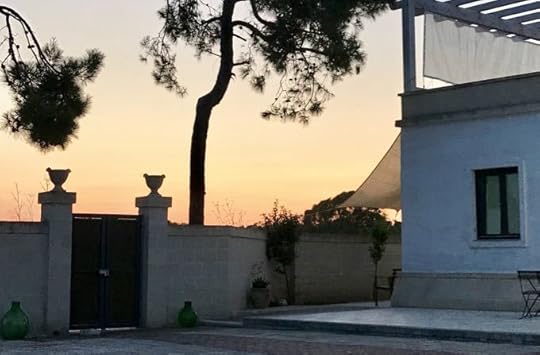
Masseria Prisuti

Agriturismo Africa, Avetrana

Antipasto di Casa, Agriturismo Africa, Avetrana
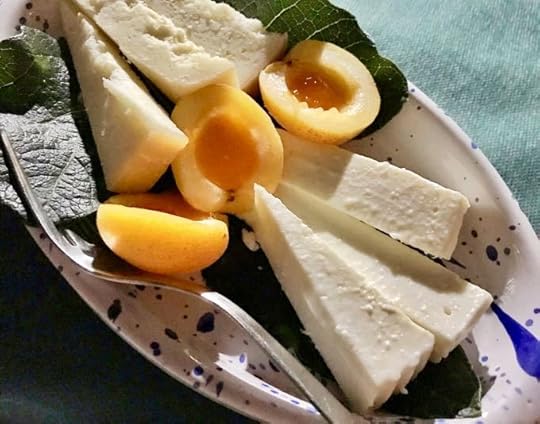
Cheese platter at Agriturismo Africa, Avetrana

Beach Restaurant at Lido degli Angeli, Punta Prosciutto

Beach lunch: friselle, tuna and veggies
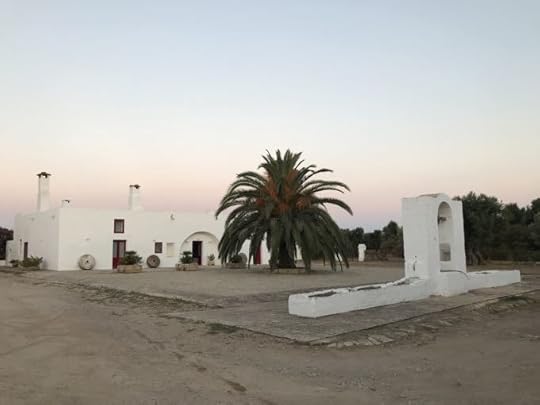
The courtyard of Masseria Fellicchie
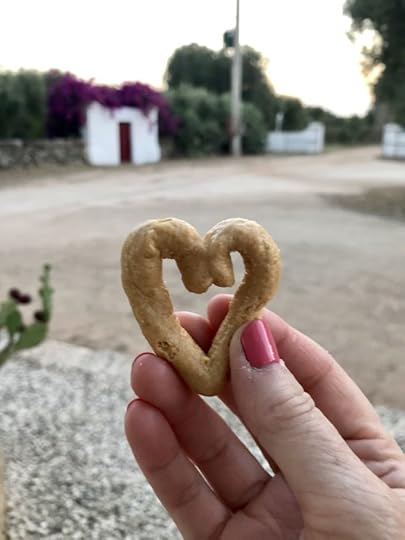

Masseria Fellicchie

Our picnic breakfast at Masseria Fellicchie: cheese, sausage, olives, tomatoes and bread.

View of the olive plantation at Masseria Fellicchie
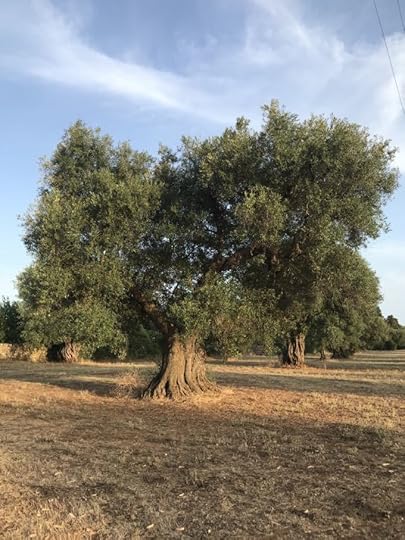
Ancient olive tree at Masseria Fellicchie

Masseria Fellicchie
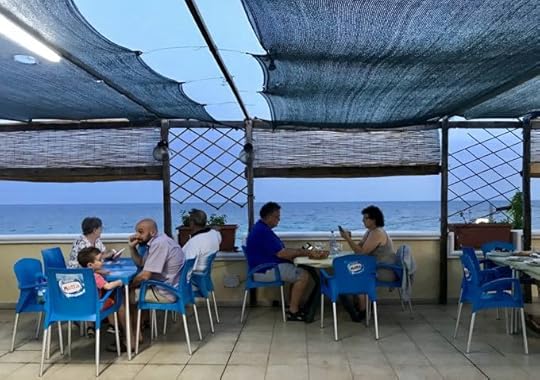
Pizzeria da Giorgio ,Torre Colimena
The post Puglia Beach Weekend appeared first on Elizabeth Minchilli.


July 1, 2019
Ristorante La Marina – Ponza
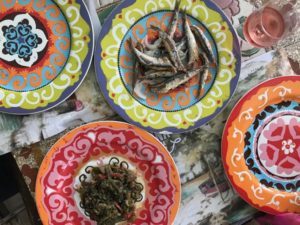
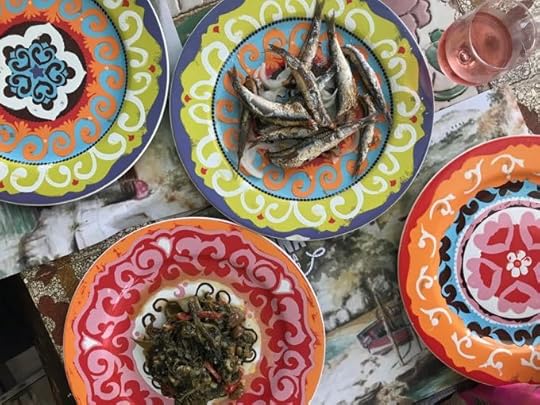
It’s not easy to get to one of my favorite beaches in Ponza. And I certainly would never had made my way there if my friend Gillian hadn’t pointed the way. Last summer I was staying in the port and Gillian was staying on the other side of the Island, in Le Forna. So I got in a taxi (there are six I think on the island) and headed up and over the hill to meet her for a pre-beach cappuccino.
The taxi driver of course knew exactly where I was going. And as we got closer to the bar he even said ‘There’s your friend.’ Ponza is that small.
After our iced cappuccino we walked past a few buildings and then down what can only be described as a kind of goat path. Actually, it’s a bit better than that, but barely. At certain points there are structures that kind of look like stairs. Creatively made stairs, each one a different height. Sometimes there was a wooden railing too.
What was constant, if you dared to look up from where your feet were? Views. Like amazing views waaaaaay down to the turquoise colored sea in what seemed to be a far away cove.
I’m exaggerating of course, but it is a hike. But a hike well worth it. Because Cala Feola is one of the few beaches on the island that you can actually get to by land. Most of the small coves around this island are boat access only. So even though it is a hike? At least it’s a hike and not a boat ride.
After what seemed like 200 steps we made it to Cala Feola, and – since Gillian knows all about these things – we had made it early enough to get a beach chair in the first row of the stabilimento near the water. And their we parked ourselves for the entire day. Taking breaks to swim, or get cool drinks from the bar magically set up behind us.
At lunch time though we took another mini hike (more of a stroll) to far end of the beach where a weather-beaten shack was perched on the rocks. La Marina is one of those perfect beach side restaurants you only find in Italy.
First of all we ordered a bottle of rose’ made from local grapes. Which of course made everything look even better. For lunch we just ordered a bunch of small plates to split. Grilled sardines, fresh and briney; a mess of escarole sauteed with olive oil, tomatoes and olives. My favorite though was their version of parmigiana. In the summer every beach side restaurant serves a version of this iconic dish. Usually it’s eggplant. Sometimes it’s zucchini (a recipe for that is in my book) But La Marina wins the award for most original Parmigiana ever: cactus paddle. It was so fresh that we actually saw them come in with the basket of freshly harvested paddles and went back into the kitchen to watch them being cleaned.
We also amused ourselves by watching people come and go, by land and by sea. (We were hoping to get a sighting of Beyonce, who is rumored to have come here last summer off her yacht. ) When the last drop of rose was finished we strolled back to our lounge chairs and napped the rest of the afternoon away. Yes, we would have a hike back up the hill, but that’s the price you pay for perfect beach day.
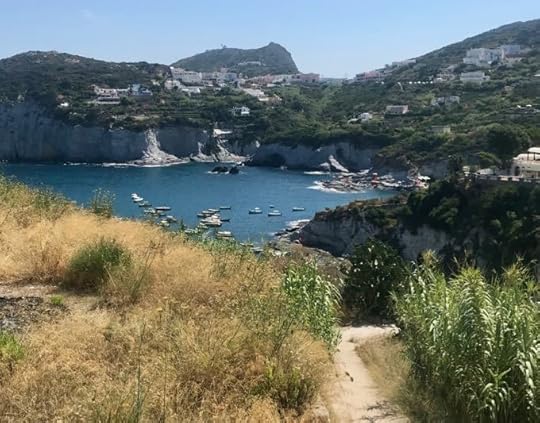
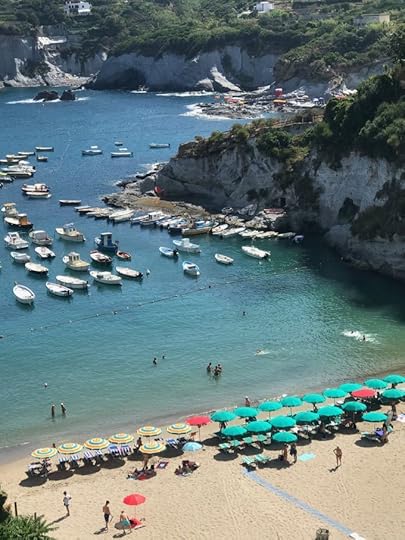
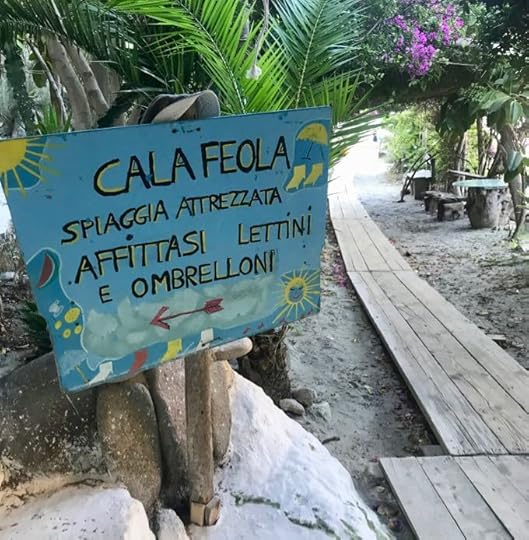
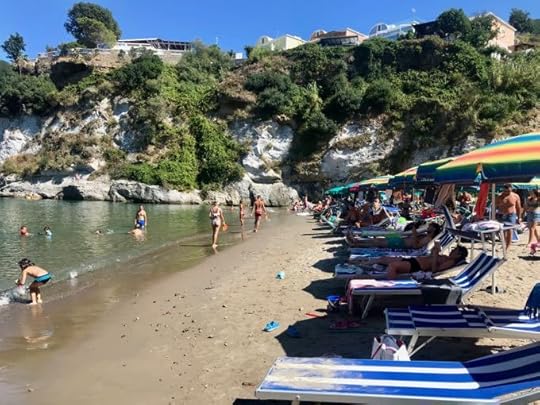
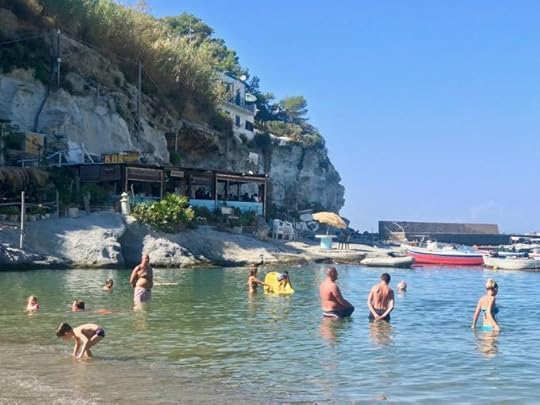
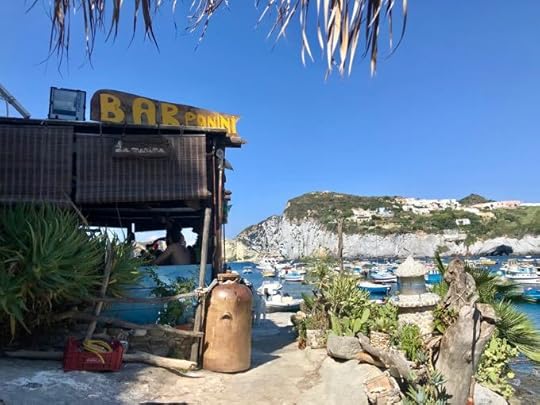
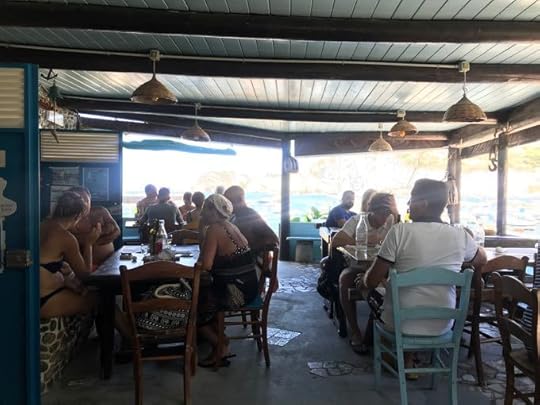
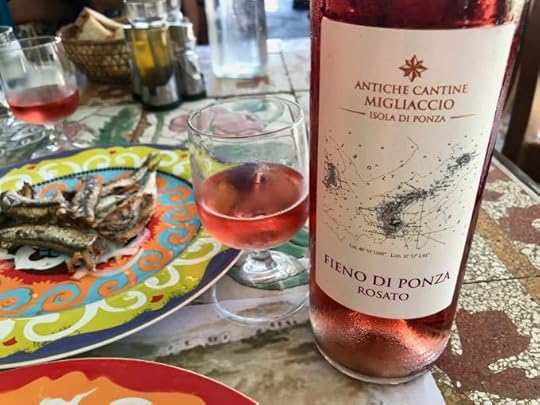
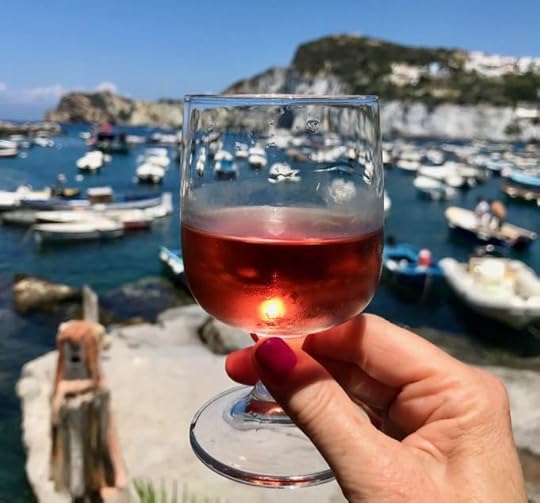
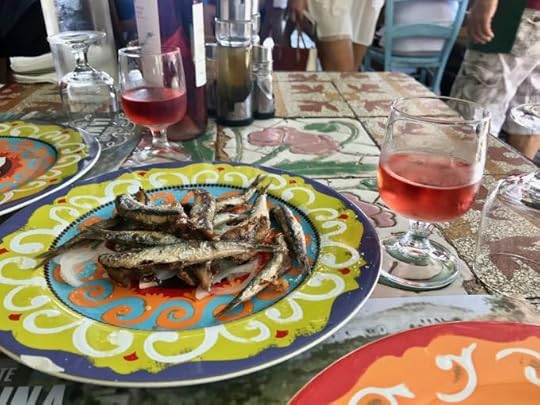
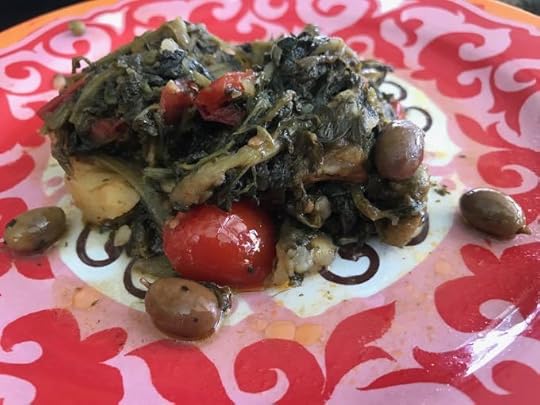
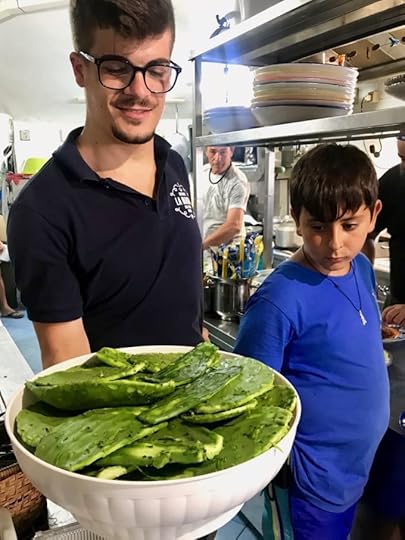
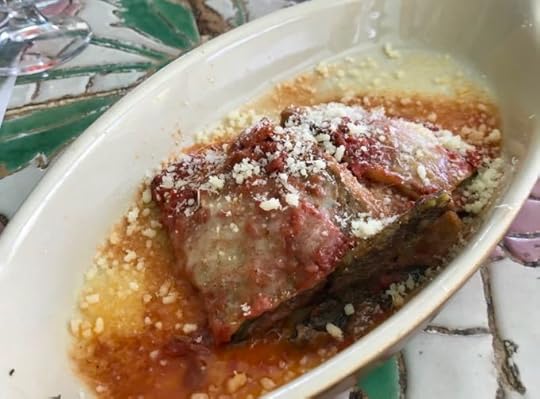
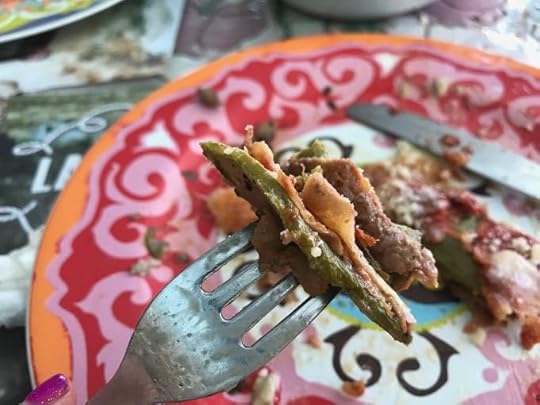
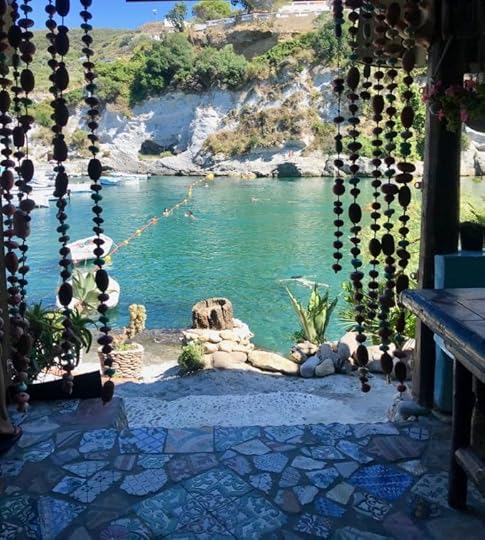
For more advise on eating in Italy download my app EAT ITALY . Eat Italy is a free app, with in-app purchases for Rome, Venice and Florence. Other cities and regions (Milan, Torino, Umbria, Puglia, Naples, Amalfi) are completely free. Thanks to the miracle of digital publishing, I’ll be updating the content constantly. Once you download EAT ITALY you will automatically receive new updates. The app is available for both iTunes and Android.
For more about traveling around Italy, following your appetite to out of the way places , buy my book Eating My Way Through Italy. And if you’d like to recreate your own Italian meal at home, my book The Italian Table: Creating Festive Meals for Family and Friends, has all the recipes you’ll need (including an entire chapter on eating on the beach in Italy)
If you’d like to join me for a Week in Italy, exploring places like these, I’d love to have you! For my current schedule see my website. And for day tours in Rome and Puglia, contact my daughter Sophie
The post Ristorante La Marina – Ponza appeared first on Elizabeth Minchilli.


Eat Amalfi – New App
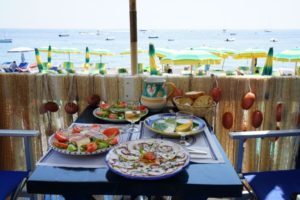
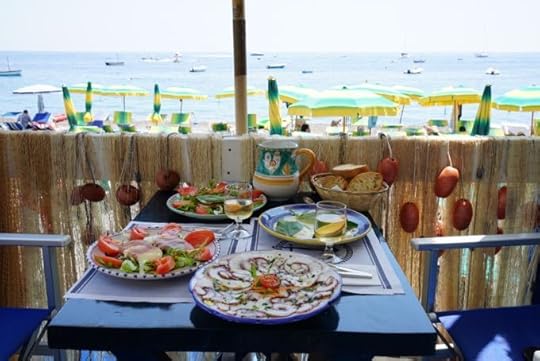
It’s taken me a while to add one of my favorite areas of Italy, the coast south of Rome, to the EAT ITALY app collection. One of the reasons is because I wasn’t quite sure what to call it. While it’s easy to figure out what the names Eat Rome, Eat Venice and Eat Florence refer to, the places that I go to south of Rome, along the coast, are grouped together more in my mind than on any map.
I first thought of calling this app Eat Positano, since there were so many places (I thought) in Positano. Then I wanted to extend it to include even more places, so thought of Eat Amalfi (referring to the Amalfi Coast more than the town itself). Or should I call it Eat Campania, and so include Naples in what (in my mind) an app basically about beach places? But when I started going to Ponza, an island off the coast of Lazio that has nothing to do with the Amalfi Coast but is certainly near enough to it to be included in a general guide, the problem got even more confusing.
In the end I decided to not really dwell on what this app is called and just get the information out there to you! So I’ve kept the name EAT AMALFI (since the name Amalfi Coast is very recognizable to most people) but added the “& More” as my way of saying I can tack on any other beachy destination in the general vicinity that I want to. This is why you’ll find Ponza here, when it really has nothing to do with The Amalfi Coast. I’ll also most likely be adding Ischia and possibly even a few spots in Capri. My reasoning is that since this is my app, I can pretty much do what I want, right?
Needless to say, this list of places to to find food or drink, in a loosely defined geographical area of Italy, is not at all exhaustive. As always this is simply a list of places that I’ve personally been to and liked. And since you have to sleep somewhere, I’m including a few hotels as well.
EAT AMALFI is one of the guides that I am offering free of cost. That is because while it still represents my favorite picks, it’s not as complete, or large, as some of the other bigger cities that are available as in-app purchases (Rome, Venice and Florence)
One of the specific challenges of this particular app is including opening hours. I’ve tried my best to be as specific as possible. Unfortunately many restaurants change their hours – and especially their vacation and holiday closures – at whim. Nowhere is this more true than in places like Ponza. They live by their own schedule and things may be open, closed or somewhere in between from day to day, or even year to year. Sorry. That’s island life.
Also, since most of the places in this app cater to people on summer holiday, many are only open from roughly May through September. If you are looking for a specific opening or closing date sorry, there usually isn’t one. And don’t tell me to look at their websites. Hah! If only. Some places do manage a Facebook page, but many haven’t been updated since 2012. Don’t fight it. Embrace it. And have another glass of white wine with peaches floating in it.
And while all of the places mentioned here are definitely open during the summer months, and mostly closed during the winter months, I am not advising you to only go during the summer. Actually? Many of the places mentioned here, especially Positano and Ponza are much much better off season, even if you will see more chiuso signs. I just spent 4 days off season in Ponza when all it did was rain and there was really only one bar open. And it was heavenly.
Thanks to the miracle of digital publishing, I’ll be updating the content constantly. Once you download EAT AMALFI you will automatically receive notices of new updates. And in fact, I have at least a dozen more entries ready to go, and will be adding them in the next month or so. So stay tuned. Once you download the app, the updates will appear magically. And if you have already downloaded EAT ITALY? Surprise!! Eat Amalfi is already on your phone, just waiting for you to use it.
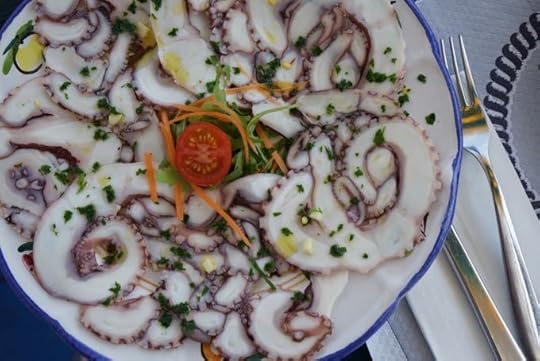
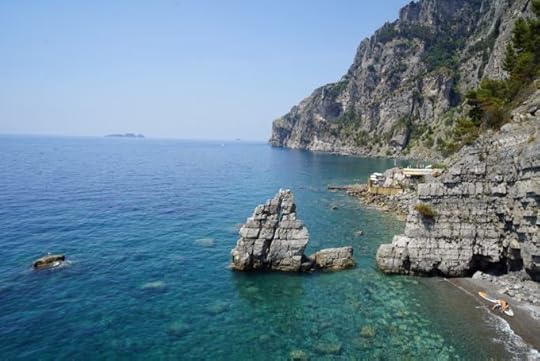
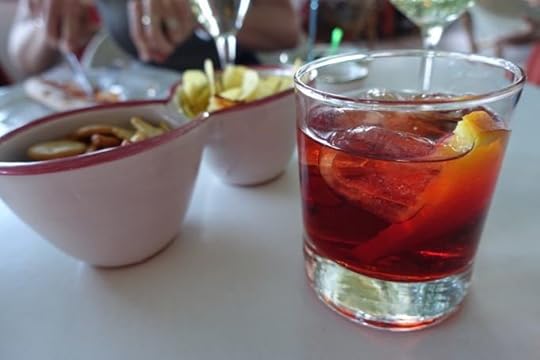
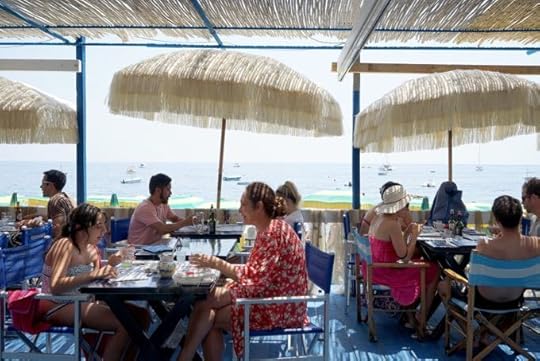
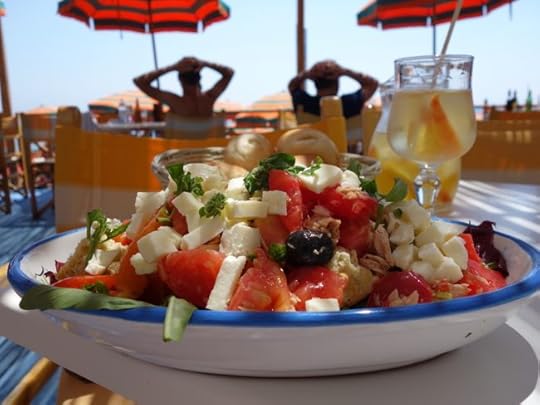
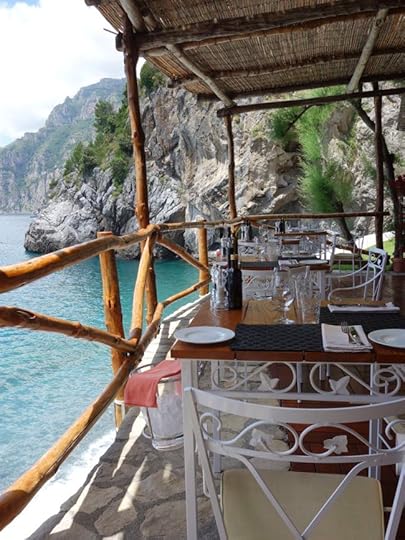
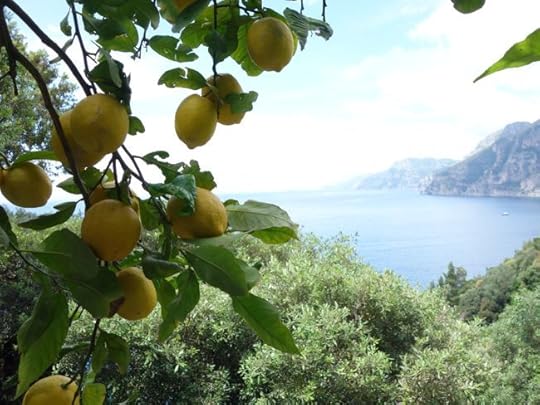
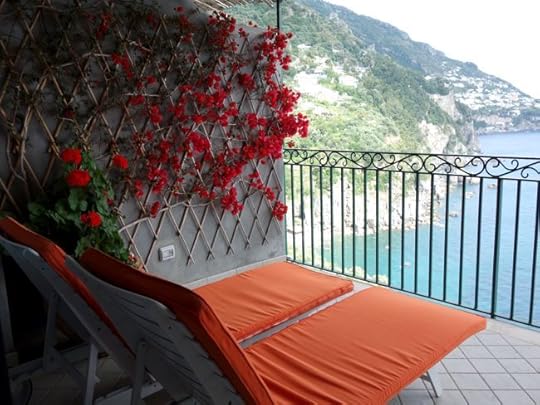
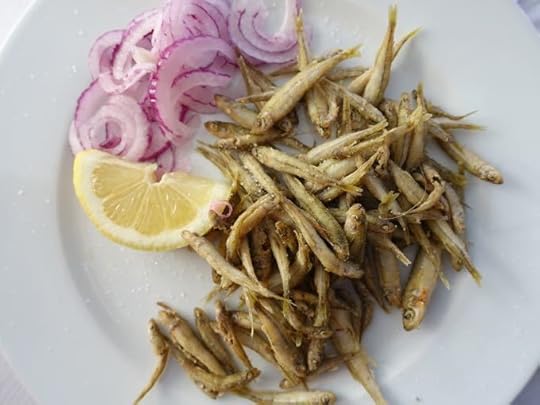
EAT ITALY is a free app, with in app purchases for Rome, Venice and Florence. Other cities and regions (Milan, Torino, Umbria, Puglia, Naples, Amalfi) are completely free. Thanks to the miracle of digital publishing, I’ll be updating the content constantly. Once you download EAT ITALY you will automatically receive new updates. The app is available for both iTunes and Android.
For more about traveling around Italy, following your appetite to out of the way places , buy my book Eating My Way Through Italy. And if you’d like to recreate your own Italian meal at home, my book The Italian Table: Creating Festive Meals for Family and Friends, has all the recipes you’ll need (plus an entire chapter on Positano)
If you’d like to join me for a Week in Italy, exploring places like these, I’d love to have you! For my current schedule see my website. And for day tours in Rome and Puglia, contact my daughter Sophie
The post Eat Amalfi – New App appeared first on Elizabeth Minchilli.





